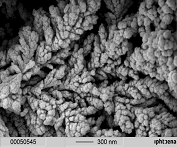Day 3 :
- Session 1: Materials Science and Engineering | Metals, Mettalurgy and Materials
Location: Olimpica 1
Chair
Nekane Guarrotxena
Spanish National Research Council (CSIC), Spain
Co-Chair
Augusto Di Gianfrancesco
Consultant, Rome Area, Italy
Session Introduction
Nekane Guarrotxena
Institute of Polymer Science and Technology - (CSIC), Spain
Title: Building up smart optical “organic-inorganic†nanosystems
Time : 09:55-10:15

Biography:
Nekane Guarrotxena has done her PhD from the University of Complutense, Madrid-Spain and Post-doctoral Research from the Ecole Nationale Supérieure of Arts and Crafts (ENSAM), Paris-France and the University of Science II, Montpellier-France. She was the Vice-Director of the Institute of Polymer Science and Technology (ICTP-CSIC) (2001-2005) and Visiting Professor at the University of California, Santa Barbara-USA and the CaSTL at University of California, Irvine-USA (2008-2011). She is currently a Research Scientist at ICTP-CSIC (Spain), Editorial Board Member of some Materials Science and Chemistry journals and External Expertise Consultant on I+D+I Management Policy for national and international agencies. Her research interest focuses on the synthesis and assembly of hybrid nanomaterials, nanoplasmonics, and their uses in nano biotechnology applications (bioimaging, drug delivery, therapy and biosensing).
Abstract:
The noticeable physicochemical properties of colloidal nanoparticles (NPs) have made this class of materials very promising for several applications in all nano-related fields (science, technology and medicine). These size- and shape- dependent tunable properties can also be tailored by surface modification, functionalization or hybridization with other nanomaterials and/or polymers for specific applications. Functionalization of inorganic nanoparticles with polymers and/or rationally designed molecules offers a pathway towards engineering responsive and multifunctional composite systems. Stimuli-responsive polymer materials respond in a dramatic way to very slight changes in their environment (stress, temperature, light, ionic strength, pH, humidity and electric or magnetic fields). So far, functional smart polymers are becoming increasingly straightforward to design and synthesize nanomaterials with a remarkable range of predictable responses and other properties. Additionally, the hybridization of NPs with stimuli responsive polymers control and stabilize their assembly, and in consequence, the symbiosis between both components (nanoparticles and wrapping polymers), can result in smart nanomaterials which combine, change or present novel properties from their individual systems. These materials are playing an increasingly relevant part in a wide range of applications, such as smart optical systems and devices, micro-electromechanical systems, coatings, biosensors and diagnostics. On the basis of the high interest within the scientific community, even when important research has been done along the last years on the polymer coating of NPs, the establishment of new protocols for their functionalization is still needed. This talk will highlight recent development in the area of multifunctional organic-inorganic hybrid nanostructures that are self-assembled from nanostructured building blocks, focusing on the improvement of nano-hybrids’ optical responses depending on the impact of pH and temperature external stimuli.
Augusto Di Gianfrancesco
Consultant, Rome Area, Italy
Title: Materials for advanced ultra-super critical power plants
Time : 10:15-10:35

Biography:
Augusto Di Gianfrancesco has been employed at the Centro Sviluppo Materiali (CSM) since February 1983 until December 2014, as a Senior Metallurgist and Project Leader for High Temperature Materials. He was responsible for R&D activities on steels and superalloys for high temperature applications in power generation plants. He was also a member of Management Committee of EU Program COST 522-536, Co-founder of the European Creep Collaborative Committee (ECCC) and Co-founder of the Italian Working Group on Creep Resistant Materials. He is an author and co-author of more than 300 technical reports and more than 100 papers presented at national and international conferences. Currently, he is Materials and Technologies Consultant and Chairman of the ECCC. He is the Editor of the “Materials for ultra-supercritical and advanced ultra-supercritical power plants”, published by Elsevier in 2016
Abstract:
Higher process temperatures and pressures are mandatory to increase net efficiency and reduce CO2 emissions. As consequence of these more severe operating conditions require better materials with higher demands for development, manufacturing and fabrication. This paper summarizes the current status of the art of the materials for ultra-supercritical coal fueled power plants and the trend for the development needed for the next generation called “advanced ultra-supercritical” targeting >50% efficiency, where nickel base superalloys will be necessary for the hottest part of the plant. This new generation of power plants will give an effort for the reduction of the CO2 emission, because forecast confirm the coal will be the most relevant source for energy production at least for the next 30 years.
Takashige Omatsu
Chiba University, Japan
Title: Helical light induced chiral surface relief in azo-polymer thin film
Time : 10:50-11:10

Biography:
Takashige Omatsu is currently serving as the Director at the Optical Society (OSA), a Deputy Editor of Optics Express, and a Director of Photonics Division, Japan Society of Applied Physics (JSAP). Furthermore, he has worked as a committee member in many international conferences. He was elected as an OSA fellow and a JSAP fellow. He has been working on structured materials fabrication based on optical vortex illumination. He has published over 200 journal and conference papers, and has attended over 100 invited presentations of international and national conferences.
Abstract:
Light induced surface reliefs on azo-polymer films have been intensely studied through mass transport arising from an optical gradient force, anisotropic photo-fluidity, and cis-trans photo-isomerization, and they provide us to develop optical devices, such as hologram, active waveguides and photonic circuits. The mass transport occurs typically to direct the azo-polymer from a bright region toward a dark region along the polarization direction of the light, thereby inhibiting a spiral surface relief formation in the azo-polymer by linearly polarized light illumination. Optical vortex, i.e. light with a helical wavefront, carries unique features, such as its annular intensity profile and orbital angular momentum, and it has been widely investigated in various applications, for instance, optical trapping and manipulation, optical telecommunications, and a super resolution microscope. Recently, we and our co-workers discovered, for the first time, that optical vortex enables the formation of a single-arm chiral surface relief in an azo-polymer with the help of the spin angular momentum assigned by the circular polarization. Such chiral surface reliefs have the potential to be utilized to develop new optical devices, including chiral metasurfaces and plasmonic holograms for identification of the chirality of chemical composites with high accuracy and sensitivity. In this presentation, we detail the chiral surface relief formation in the azo-polymer by optical vortex illumination, and we also address the physical mechanism of the chiral surface relief formation by utilizing an analytical formula for the optical radiation force induced in an isotropic and homogeneous material by irradiation with a continuous-wave optical vortex.
Recent Publications
- Barada D, Juman G, Yoshida I, Miyamoto K, Kawata S, Ohno S, Omatsu T (2016) Constructive spin-orbital angular momentum coupling can twist materials to create spiral structures in optical vortex illumination. Applied Physics Letters 108: 051108.
- Takahashi F, Miyamoto K, Hidai H, Yamane Y, Morita R, Omatsu T (2016) Picosecond optical vortex pulse illumination forms a monocrystalline silicon needle. Scientific Reports 6: 21738.
- Takahashi F, Takizawa S, Hidai H, Miyamoto K, Morita R, Omatsu T (2016) Optical vortex pulse illumination to create chiral monocrystalline silicon nanostructures. Physica Status Solidi (a) 213: 1063-1068.
- Watabe M, Juman G, Miyamoto K, Omatsu T (2014) Light induced conch-shaped relief in an azo-polymer film. Scientific Reports 4: 4281.
- Toyoda K, Takahashi F, Takizawa S, Tokizane Y, Miyamoto K, Morita R, Omatsu T (2013) Transfer of light helicity to nanostructures. Physical Review Letters 110: 143603.
Alexander M Korsunsky
University of Oxford, UK
Title: Multi-scale deformation analysis in a thermoplastic polyurethane
Time : 11:10-11:30

Biography:
Alexander M Korsunsky is experienced in engineering microscopy of materials systems and structures for optimization of design, durability and performance at the University of Oxford, UK. He leads the Centre for In-situ Processing Science (CIPS) at Research Complex, Harwell. He a Consultant at Rolls-Royce Corp. on matters of residual stress and structural integrity, and is an Editor-in-Chief of Materials & Design, a major Elsevier journal (2016 impact factor 3.997). He has done his Doctor of Philosophy (DPhil) from Merton College, Oxford, and undergraduate education in Theoretical Physics. He was a Junior Research Fellow at Fitzwilliam College, Cambridge, and Lecturer at Newcastle University.
Abstract:
Thermoplastic polyurethane (TPU) elastomers are applied in a variety of situations, from medical devices to sports equipment. The block co-polymer structure of these materials engenders nano-scale structural inhomogeneities, resulting in non-uniform strain fields that depend on the scale of consideration. In order to elucidate the nature of deformation in such materials, we focus our attention on the transition between the hard and soft regions that have been called "fuzzy interfaces". To obtain experimental insights into these deformation phenomena we used a range synchrotron X-ray methods ranging from imaging to small angle scattering (SAXS) to diffraction (WAXS). Subsequent analysis by finite element modeling (FEM) and fast Fourier transformation (FFT) allowed agreement to be achieved between predicted and observed scattering patterns, providing the explanation for the observed 'strain deficit' at the nano-scale.
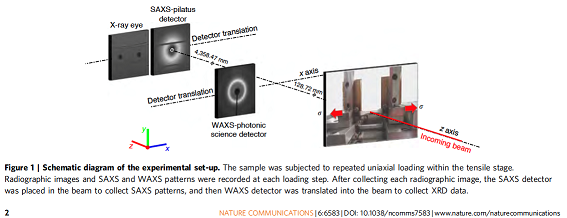
John Roberts
University of Liverpool, UK
Title: Proposed link between the periodic table and the standard model
Time : 11:30-11:50

Biography:
John O Roberts has been a Tutor at the Open University Science for 30 Years. He has worked at the Rutherford-Appleton Lab and CERN. He has been a freelance tutor of Math, Physics and Chemistry for many years. He is the author of book “Those infinities and the periodic table”.
Abstract:
The patterns of stable quantum states in the periodic table are inverted and extended to infinity in both directions to accommodate spatial variation relative to the nucleus. The upper end leads to a cut off point for white matter. The lower end represents quantum states in plasma. At 10-15m to 10-20m the interaction between weak strong and gravity forces results in suitable boundary conditions for the production of elementary particles. Chemical classification of the elements requires convergence of chemical properties and quantum states. By defining group number as the maximum number of electrons in any one shell, hydrogen and helium are moved to the first set of 2(1)2 states first proposed by Janet. The atomic numbers are adjusted and mass number removed as it is an average of isotopes of each element produced in every supernova. This produces the Roberts Janet nuclear periodic table which proposes two zero states, a cut off and start point, of the electric field in attractive then repulsive modes. By symmetry of these fields energy states emerge in plasma with the counter intuitive property that the nearer the nucleus the greater the number of energy states. Fusion results and the consequential recycling implies a more rapid collapse than supernovae given sufficient energy density that could create an as yet unobserved interaction at 10-50m to 10-65m between the strong and gravity forces. String theory and extra dimensions may be required to explain such mechanisms and multiverses.
Kimihisa Yamamoto
Tokyo Institute of Technology, Japan
Title: Fine-controlled subano-metal particles in a dendrimer reactor
Time : 11:50-12:10

Biography:
Kimihisa Yamamoto has received his PhD degrees from Waseda University in Polymer Chemistry in 1990. He joined the Department of Chemistry at Keio University in 1997 as a Professor. Currently, he is a Professor in the Chemical Resources Laboratory, Tokyo Institute of Technology, since 2010. His present research interests are in developing supra-metallomolecules for nanosynthesizers involving nanoparticles, subnanoparticles and superatoms.
Abstract:
We show that tin chlorides, SnCl2 and FeCl3 complexes to the imines groups of a spherical polyphenyl-azomethine dendrimer in a stepwise fashion according to an electron gradient, with complexation in a more peripheral generation proceeding only after complexation in generations closer to the core has been completed. The metal-assembly in a discrete molecule can be converted to a size-regulated metal cluster with a size smaller than 1nm as a molecular reactor. Due to the well-defined number of metal clusters in the sub-nanometer size region, its property is much different from that of bulk or general metal nanoparticles. Dendrimers are highly branched organic macromolecules with successive layers or “generations” of branch units surrounding a central core. Organic inorganic hybrid versions have also been produced, by trapping metal ions or metal clusters within the voids of the dendrimers. Their unusual, tree-like topology endows these nanometer-sized macromolecules with a gradient in branch density from the interior to the exterior, which can be exploited to direct the transfer of charge and energy from the dendrimer periphery to its core. Here we show that tin ions, Sn2+, complex to the imines groups of a spherical poly phenyl azo- methane dendrimer in a stepwise fashion according to an electron gradient, with complexation in a more peripheral generation proceeding only after complexation in generations closer to the core has been completed. By attaching an electron-withdrawing group to the dendrimer core, we are able to change the complexation pattern, so that the core imines are complexed in the last. By further extending this strategy, it should be possible to control the number and location of metal ions incorporated into dendrimer structures, which can be used as tailored catalysts, building blocks, or fine-controlled clusters for advanced materials.
Hiroyuki Aoki
Japan Atomic Energy Agency, Japan
Title: Structure and dynamics of polymer materials at the single molecule scale studied by novel fluorescence microscopy techniques
Time : 12:10-12:30

Biography:
Hiroyuki Aoki is a Senior Scientist in Materials and Life Science division, J-PARC Center, Japan Atomic Energy Agency. He obtained his degrees of BE, ME and PhD from Kyoto University in 1996, 1998 and 2001, respectively. He became an Assistant Professor of Department of Polymer Chemistry, Kyoto University in 2001 and was promoted to an Associate Professor in 2006. In 2016, he moved to J-PARC as a Senior Scientist. His research interests are focused on structure and dynamics of polymer materials at the single molecule scale. He was awarded with the Inoue Research Award for Young Scientist from Inoue Foundation for Science (2002), Young Scientist Lectureship Award (2008), SPSJ Award for the Outstanding Paper in Polymer Journal (2008), and SPSJ Science Award from the Society of Polymer Chemistry, Japan (2016)
Abstract:
Polymer materials have been widely used in various scenes of our daily life because the polymers show unique physical properties. The origin of the polymer materials is the large entropy of a single molecule, which has a long chain-like structure with a large molecular weight. Therefore, the conformation of the single polymer chain has been the key problem in polymer physics. However, because the single polymer chain, show great complexity in the structure and molecular motion due to its large degree of freedom for the molecular structure, it has been difficult to obtain the direct information on the single chain by the conventional experimental techniques. In this talk, the author will present the novel methodology to examine the structure and dynamics of the single chain in a polymer material. In a bulk polymer material, a polymer chain takes a random coil conformation expanded in three dimensions and entangled with the surrounding chains. In order to extract the information from a single chain, it should be labeled by a fluorescent moiety. However, the conventional fluorescence microscopy does not have the high resolution to observe the single polymer chain. Recent development of super-resolution microscopy allows the fluorescence imaging with the spatial resolution on the order of 10 nm. The author has introduced this technique for the structural analysis of polymer materials. The fluorescence labeling of poly(methyl methacrylate) chain with a photo-switchable rhodamine dye and the astigmatic detection optics enabled the three-dimensional analysis of the chain conformation. The super-resolution microscopy reveled the molecular behaviorin the macroscopic deformation process.
Recent Publications:
- Aoki H, Mori K, Ito S (2012) Conformational analysis of single polymer chains in three dimensions by super-resolution fluorescence microscopy. Soft Matter 8: 4930-4935.
- Ube T, Aoki H, Ito S, Horinaka J, Takigawa T (2012) Relaxation of single polymer chain in binary molecular weight blends observed by scanning near-field optical microscopy. Soft Matter 8: 5603-5611.
- Ube T, Aoki H, Ito S, Horinaka J, Takigawa T, Masuda T (2011) Relaxation of single polymer chain in poly(methyl methacrylate) films under uniaxial extension observed by scanning near-field optical microscopy. Macromolecules 44: 4445-4451.
- Aoki H, Takahashi T, Tamai Y, Sekine R, Aoki S, Tani K, Ito S (2009) Poly(methacrylate)s labeled by perylenediimide: Synthesis and applications in single chain detection studies. Polym. J. 41: 778-783.
- Ube T, Aoki H, Ito S, Horinaka J, Takigawa T, Masuda T (2009) Affine deformation of single polymer chain in poly(methyl methacrylate) films under uniaxial extension observed by scanning near-field optical microscopy. Polymer 50: 3016-3021.
Taeyoon Lee
Yonsei University, Republic of Korea
Title: Development of highly stretchable conductive fiber and fiber-based electronic sensors for textile electronics
Time : 12:30-12:50

Biography:
Taeyoon Lee has his expertise in developing conductive fiber with high performances and fiber-based electronic devices for various applications such as wearable, stretchable electronics and smart textiles. He joined the School of Electronic and Electrical Engineering in Yonsei University as an Assistant Professor in 2007 and now he is an Associate Professor. He received his BS and MS from Yonsei University and his PhD from UIUC in 2004 in Materials Science. Before joining Yonsei University as an Assistant Professor, he had worked as a Senior Process Engineer at Intel for 2005-2007.
Abstract:
Recent studies on electronic textile (E-textile) where various electronic elements are fabricated into fabrics have attracted considerable attention for the advanced wearable and flexible devices. Especially, textile-based pressure sensor have been widely explored for a lot of applications such as detecting vital signals of patients, diagnostic and motion detection by embedding them in clothes. For the realization of the highly sensitive textile-based pressure sensors, various types of pressure sensors such as capacitive, piezoelectric, piezoresistive and optical types have been investigated. Among these various types of sensors, capacitive pressure sensors have advantages in terms of simple design and analysis of the devices, high sensitivity, excellent stability and low power consumption. However, since fabrication of the sensors with high performances is difficult due to limitations of techniques and materials, it is very challenging to apply these capacitive fabric pressure sensors to advanced wearable devices. Here, we describe high-performance fiber-based pressure sensor, strain sensor, and multimodal sensor. For the development of the fiber-based sensors, a highly stretchable conductive fiber, which effectively overcomes the limitations of previous stretchable conductive fibers, was fabricated by combining metal nanoparticles and bio-inspired elastomeric fibers. The conductive fiber exhibits an excellent conductivity of 20.940 S/cm, superb stretchability of 450%, and high stability over 10,000 cycles. By using the conductive fiber, various fiber-based mechanical sensors such as a pressure sensor, strain sensor, and multimodal sensors were successfully fabricated. The fiber-based sensors have an unprecedented performance and can be easily integrated into fabrics, gloves, and clothes using a simple sewing method.
Atsushi Kubo
The University of Tokyo, Japan
Title: Finite-element analysis of velocity mode transition of crack propagation in rubber materials
Time : 13:30-13:50

Biography:
Atsushi Kubo received his Doctorate degree in Mechanical Engineering from the University of Tokyo in 2015. His research interest is in a wide range of the computational simulation and modeling (mainly at the atomistic level) for the structural and functional materials, including semiconducting materials, ferroelectric materials, polymers, etc. In his current work at the Institute of Industrial Science, The University of Tokyo, he is investigating the mechanical properties of the structural polymers based on the atomistic- and macroscopic-level approaches.
Abstract:
Crack propagation in rubber materials has been intensively investigated because it is one of fundamental processes of failure in rubber materials and is strongly related to the lifetime of rubber products. Some experiments have observed dynamic crack propagation in stretched rubber sheets and reported an interesting phenomenon called the "velocity mode transition". The mode transition is an abrupt change of tendency in the relationship between the crack propagation velocity and the tearing energy (or the loaded strain), as schematically shown in Fig. 1. There are two regions below and above a certain transition point, which are referred to as the "slow mode" and the "fast mode", respectively. According to the experiments, the crack velocity exhibits a nearly discontinuous change by more than two orders of magnitude at the transition point. While the behavior of a propagating crack at the fast mode can be explained theoretically, the mechanism of the mode transition phenomenon has been still unclear despite its importance. Furthermore, no numerical simulation has been established to reproduce the transition phenomenon thus far. In this talk, we present a series of analyses based on the finite element method (FEM) for purpose of revealing the mechanism of the mode transition phenomenon. We carried out FEM simulations of the pure-shear test to mimic a precedent experiment and obtained the relationship between the loaded strain and the crack propagation velocity. The material model consists of the hyper elasticity and viscosity, which were determined to reproduce the mechanical properties of a filled elastomer. As a result, the mode transition phenomenon was reproduced by the present FEM analyses, which revealed that the mode transition correlates to the viscoelastic behavior with a wide range of time scale. The mechanism of the transition phenomenon was well explained through a characteristic mechanical behavior at the crack tip.
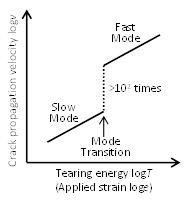
Recent Publications
- Kubo A, Umeno Y (2017) Velocity mode transition of dynamic crack propagation in hyper viscoelastic materials: A continuum model study. Scientific Reports 7: 42305.
- Iskandarov A M, Kubo A, Umeno Y (2015) Development of a new dipole model: Interatomic potential for yttria-stabilized zirconia for bulk and surface. Journal of Physics: Condensed Matter 27: 015005.
- Umeno Y, Kubo A, Nagao S (2015) Density functional theory calculation of ideal strength of SiC and GaN: Effect of multi-axial stress. Computational Materials Science 109: 105-110.
- Kubo A, Wang J, Umeno Y (2014) Development of interatomic potential for Nd-Fe-B permanent magnet and evaluation of magnetic anisotropy near interface and grain boundary. Modeling and Simulation in Materials Science and Engineering 22: 065014.
- Kubo A, Albina J M, Umeno Y (2013) Atomistic study of stress-induced switching of 90-degree ferroelectric domain walls in PbTiO3: Size, temperature, and structural effect. Modeling and Simulation in Materials Science and Engineering 21: 065019.
Stefano L Oscurato
University of Naples, Italy
Title: Light driven directional mass transport of azo-benzene containing materials for complex tri-dimensional structures on surfaces
Time : 13:50-14:10

Biography:
Stefano L. Oscurato graduated as MSc in Physics at University of Naples "Federico II" Italy, with a Master's dissertation about the development of a holografic scanning microscopy techique. He is doing his doctoral studies at University of Naples at the nano-optics laboratory, supervised by Prof. Pasqualino Maddalena and Dr. Antonio Ambrosio. His PhD work is about the use of light-driven mass migration in azobenzene-cointaing materials for application in photonics, wettability and adehision.
Abstract:
Inspired by nature, in the last years the role of the topography of superficial textures in determining surface functionalities is increasingly recognized and the fabrication of controlled tridimensional textures became a demanding point of material science because of the potential applications in many fields as photonics, functional and smart surfaces. Standard fabrication techniques, including photo-lithography, electron beam and focused ion beam lithography, self-assembly, soft lithography, etc., often require multi-step processes in order to realize 3D architectures and the fabricated geometries are rarely further tunable. However, the light-induced mass migration phenomenon arising in photo-responsive azo-benzene containing materials opens to new fabrication approaches. Under illumination, the azo-benzene molecules exhibit photo-isomerization trans-cis-trans cycles. This microscopic motion drives a reorganization of the host material, typically a polymer, in which the molecules are embedded, resulting in a macroscopic material displacement. This material motion is highly directional and occurs in the illuminating light polarization direction. Recently, our group proposed phenomenological models to deterministically predict the topography of the azo-surfaces resulting from light-surface interaction in different configurations. So the light-driven mass migration can be actually used to fabricate new classes of surface topographies, which can be even further modified once fabricated. Here, we demonstrate the potentiality of this technique by realizing tri-dimensional complex superficial patterns based either on spatially structured illumination light patterns or on reshaping of pre-patterned surface architectures. Spatially modulated intensity patterns are achieved in a versatile way by phase-modulating a laser beam through a computer controlled spatial light modulator, resulting in topography modulation of the azo-surfaces, even with high spatial resolution. On the other side, tri-dimensional architectures are obtained by reshaping pristine pre-patterned micron-posts in simple illumination condition. These resulting structures are proven to produce a change in the wetting behavior of the textured surface with a demonstrated controlled directional droplet spreading.

Francis Opaku
University of Johannesburg, South Africa
Title: Enhancing the photocatalytic activity for pollutant degradation and H2 evolution by modifying ZrO2 with nanoclusters of BiVO3, Ag3PO4, SrTiO3 and WO3: A first-principles study
Time : 14:10-14:25

Biography:
Francis Opoku received his BSc in Chemistry (2010) and MPhil in Inorganic Chemistry (2014) from the Kwame Nkrumah University of Science and Technology, Ghana. He is now pursuing PhD degree in Chemistry under the supervision of Dr. Penny Poomani Govender, Dr. Krishna Kuben Govender and Dr. Cornelia Gertina Catharina Elizabeth van Sittert in the Department of Applied Chemistry, University of Johannesburg, South Africa. His research interests include the design of efficient semiconductor-based photocatalyst materials and their applications in water splitting as well as degradation of pollutants in wastewater/water resources.
Abstract:
Environmental pollution and energy exhaustion has received much interest both in scientific and industrial research fields. For this reason, tremendous efforts are made to design novel environmentally friendly non-polluting and sustainable energy storage photocatalysts for efficient solar energy harvesting and conversion. Semiconductor-based photocatalysis has received increasing attention in energy storage and environmental remediation process due to the abundantly solar energy. For this purpose, several heterostructures using BiVO4, Ag3PO4, SrTiO3 and WO3 monolayers coupled with ZrO2 nano-cluster are designed to examine their potential applications in energy storage and degradation of pollutants using density functional theory calculations for the first time. Moreover, the underlying mechanism, band edge positions, optical and electronic properties of the ZrO2-basedheterostructures are evaluated. The results displayed that the calculated band gap of the heterostructures is reduced compared to the pure ZrO2, which favors redshift absorption. A type-I band alignment was attained for the BiVO4/ZrO2, Ag3PO4/ZrO2 and WO3/ZrO2 hetero-structures. More importantly, the type-II staggered band alignment formed in the SrTiO3/ZrO2 heterostructure restrained the charge recombination rate of the photoinduced carrier charges, as well as enhancing the photocatalytic activity. Our results display efficient charge separation and visible light response of the BiVO4/ZrO2, Ag3PO4/ZrO2, WO3/ZrO2 and SrTiO3/ZrO2 heterostructures. In particular, suitable band alignment of SrTiO3/ZrO2 with enough driving forces for charge carrier transfer show overall water splitting and degradation of pollutant in which SrTiO3 acted as the charge separation center. Thus, the SrTiO3/ZrO2 heterostructure emerges as a new type of ZrO2-based photocatalyst for efficient solar energy applications. Furthermore, h+, HO• and O2−• radicals played a major role in the photocatalysis process. Finally, possible charge separation and photocatalytic mechanisms of BiVO4/ZrO2, Ag3PO4/ZrO2, WO3/ZrO2 and SrTiO3/ZrO2 heterostructures are proposed.
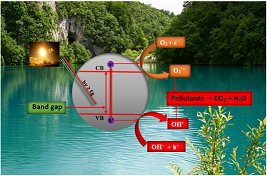
Recent Publications:
- Boateng T K, Opoku F, Acquaah S O, Akoto O (2016) Groundwater quality assessment using statistical approach and water quality index in Ejisu-Juaben Municipality, Ghana. Environmental Earth Sciences 75:1-14.
- Nkansah M A, Opoku F, Ackumey A A (2016) Risk assessment of mineral and heavy metal content of selected tea products from the Ghanaian market. Environ. Monit. Assess 188: 1-11.
- Nkansah M A, Opoku F, Ephraim J H, Wemegah D D, Tetteh L P (2016) Characterization of beauty salon wastewater from Kwame Nkrumah University of Science and Technology, Kumasi, Ghana, and its surrounding communities. Environ. Health Insights 10: 147.
- Opoku F, Asare-Donkor N K, Adimado A A (2015) Quantum mechanical study of the kinetics, mechanisms and thermodynamics of the gas-phase decomposition of Pb[(iPr)2PSSe]2 single-source precursor. J. Organomet. Chem. 787:33-43.
- Opoku F, Asare-Donkor N K, Adimado A A (2014) Theoretical study of the gas-phase decomposition of Pb[(C6H5)2PSSe]2 single-source precursor for the chemical vapor deposition of binary and ternary lead chalcogenides. Can. J. Chem. 93: 317-325.
- Session 2: Nanomaterials
Location: Olimpica 1
Chair
Hikaru Kobayashi
Osaka University, Japan
Co-Chair
Marzia Quaglio
Italian Institute of Technology, Italy
Session Introduction
Hikaru Kobayashi
Osaka University, Japan
Title: Si nanopowder for internal hydrogen generation materials
Time : 14:25-14:45

Biography:
Hikaru Kobayashi received Doctor of Science in Chemistry from Kyoto University in 1984. He was a Post-doctoral fellow at Physics department in University of Pennsylvania between 1984 and 1986, and then he started working at the Matsushita Electronics Company. He became an Associate Professor of Faculty of Engineering Science, Osaka University in 1990, and moved to Institute of Scientific and Industrial Research of Osaka University as a Full Professor. He has been performing researches on fabrication of Si nanopowder, its application to hydrogen generation material, anode material in Li ion batteries, and luminescent material. He has also been studying material science related to crystalline Si solar cells, especially surface and interface control to improve conversion efficiencies.
Abstract:
Although Si bulk doesn’t strongly react with water, Si nanopowder reacts with it when its size is less than ~20 nm, leading to generation of hydrogen. In previous literature, reactions of Si nanopowder with strong alkaline solutions have been investigated to achieve high hydrogen generation rates for application to e.g., fuel cells. In the present study, we have aimed at generation of hydrogen in internal conditions. Hydrogen generated in the body, especially in bowels, is effectively absorbed, is circulated, and reacts with hydroxyl radicals which cause various diseases such as cancer, Alzheimer’s disease, Parkinson’s disease, etc. Figure 1 shows the concentration of hydrogen generated by the reaction of 1 g Si nanopowder with water in the neutral pH region. Hydrogen was generated even with ultrapure water, but the generation rate was very low. The hydrogen generation rate greatly increased with pH while pH didn’t change after the hydrogen generation reaction. Therefore, the reaction schemes are written as:
Si+2OH-→SiO2+H2+2e, (1)
2H2O+2e→H2+2OH-. (2)
In the initial reaction, Si reacts with OHï¼ ions to generate hydrogen, SiO2, and electrons most probably in the SiO2 conduction band. In the subsequent reaction, generated electrons are accepted by water molecules, resulting in formation of hydrogen and OHï¼ ions. Reaction (1) is the rate-determining step, and thus, the reaction rate greatly increases with pH. The above result indicates that when Si nanopowder is taken, it doesn’t react in stomach under acidic conditions due to gastric acid, but reacts with water in bowels in alkaline conditions because of pancreatic juice. We have performed hydrogen generation experiments under conditions similar to bowels, i.e., pH 8.3 and 36ºC. In this case, more than 300 mL hydrogen was generated from 1g Si for 20 h. This hydrogen volume corresponds to that contained in more than 17 L saturated hydrogen-rich water.
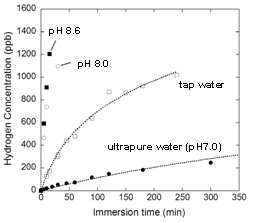
Recent Publications:
- Imamura K, Irishika D, Kobayashi H, (2017) Mechanism of ultra-low reflectivity for nanocrystalline Si/crystalline Si structure formed by surface structure chemical transfer method. J. Appl. Phys. 121: 013107-1-5.
- Imamura K, Kimura K, Fujie S, Kobayashi H, (2016) Hydrogen generation from water using Si nanopowder fabricated from Si swarf. J. Nanopart. Res. 18: 116-1-7.
- Matsumoto T, Maeda M, Kobayashi H (2016) Photoluminescence enhancement of adsorbed species on Si. Nanoscale Res. Lett. 11: 7-1-6.
- Matsumoto T, Maeda M, Furukawa J, Kim W B, Kobayashi H (2014) Si nanoparticles fabricated from Si swarf by photochemical method. J. Nanopart. Res. 16: 2240-1-7.
Marzia Quaglio
Italian Institute of Technology, Italy
Title: N-doped carbon-based nanofibers as oxygen reduction reaction catalysts
Time : 14:45-15:05

Biography:
Marzia Quaglio is a Researcher at the Center for Space Human Robotics of the Italian Institute of Technology (IIT). She graduated in Materials Engineering at the Politecnico di Torino and received her PhD in Electronic Devices from the Politecnico di Torino. Her research activity started with a main focus on MEMS/NEMS processing for the fabrication of life-science devices. She collaborated with Professor Cerrina at the University of Wisconsin, Madison for her research work. In 2009, she joined IIT contributing in the start-up of the Center for Space Human Robotics. She is currently involved in the Reactors and Processes division, with interest in the development of new electrode materials and catalysts for (bio)-electrochemical systems for CO2 conversion.
Abstract:
This work is focused on the development of N-doped carbon nanofibers (N-CNFs) as catalyst for the oxygen reduction reaction (ORR). In devices for energy storage and production, as microbial fuel cells and li-air batteries, oxygen can be used as the terminal electron acceptor. The overall efficiency of these devices is limited by the low kinetics of the ORR. A catalyst layer must be used, to enhance the direct ORR, ensuring a number of electrons as close as possible to the ideal value of 4. Platinum is currently the best performing catalyst, however its scarcity, limited durability and high-cost, have made necessary to identify efficient substitutes. In this view nanomaterials can play a crucial role for further improvement in this area of catalysis. The development of nonprecious materials as alternative catalysts is among the pursued strategies. Nanostructured non-metal carbon-based materials, especially doped with heteroatoms like nitrogen, have established among the most promising noble metal free alternatives. In this work focus is given to the optimization of N-CNFs, especially in terms of their content of graphitic, pyrrolic and pyridinic nitrogen defects, as well as their high surface area. N-CNFs have been prepared by electrospinning, starting from a polymeric solution of polyacrylonitrile in N,N-dimethylformamide. As fabricated nanofibers were stabilized at 280ºC in air and then thermally treated up to 900ºC under inert atmosphere. X-ray photoelectron spectroscopy confirmed a high content of graphitic nitrogen and a proper amount of pyridinic one in CNFs, leading thus to improve ORR performances. Good electrochemical properties of the samples were established by rotating ring disk electrode (RRDE). An electron transfer number of 3.9 has been obtained for the N-CNFs processed at the higher temperature.
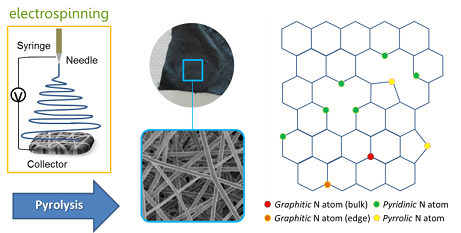
Recent Publications:
- Delmondo L, Salvador G P, Muñoz-Tabares J A, Sacco A, Garino, N, Castellino M, Gerosa M, Massaglia G, Chiodoni A, Quaglio M (2016) Nanostructured MnxOy for oxygen reduction reaction (ORR) catalysts. Applied Surface Science 388: 631-639.
- Garino N, Sacco A, Castellino M, Muñoz-Tabares J A, Chiodoni A, Agostino V, Margaria V, Gerosa M, Massaglia G, Quaglio M (2016) Microwave-assisted synthesis of reduced graphene oxide/SnO2 nanocomposite for oxygen reduction reaction in microbial fuel cells. ACS Applied Materials & Interfaces 8: 4633.
Mineo Hiramatsu
Meijo University, Japan
Title: Controlled synthesis of vertical and planar graphenes using plasma-enhanced chemical vapor deposition
Time : 15:05-15:25

Biography:
Mineo Hiramatsu is a Full Professor in the Department of Electrical and Electronic Engineering and the Director of Nanocarbon Research Center, Meijo University, Japan. He also serves as the Director of Research Institute, Meijo University. He served as the Director of the Japan Society of Applied Physics. His main fields of research are plasma diagnostics and plasma processing for the synthesis of thin films and nanostructured materials. He is the author of more than 100 scientific papers and patents on plasma processes for materials science. He is a member of organizing and scientific committees of international conferences on plasma chemistry and plasma processing: International Conference on Reactive Plasmas, International Symposium on Advanced Plasma Science and its Applications for Nitrides and Nanomaterials, International Symposium on Dry Process, International Conference on Advanced Nanomaterials, THERMEC, International Conference on Processing and Manufacturing of Advanced Materials.
Abstract:
Graphene is a promising material for future electronic applications due to its outstanding properties. Planar graphene films have been synthesized using mechanical exfoliation from HOPG and chemical vapor deposition (CVD) on metals such as Ni and Cu. On the other hand, plasma-enhanced CVD (PECVD) is among the early methods to synthesize vertically standing few-layer graphenes or carbon nano walls (CNWs). CNWs are few-layer graphenes standing vertically on a substrate to form a self-supported network of wall structures. The maze-like architecture of CNWs with large-surface-area graphene planes would be useful as electrodes for energy storage devices, electrochemical and biosensors, and scaffold for cell culturing. We have investigated the synthesis of CNWs and planar few-layer graphene using PECVD with controlling the ion flux incident on the substrate and surface pretreatment. In the present study, CNW growth using inductively coupled plasma (ICP) enhanced CVD is featured, since the ICP CVD system has advantages of simple design and scalability to large area growth. Figures 1(a) and (b) show SEM images of CNWs grown using ICP. Typical Raman spectra of CNWs and planar few-layer graphene are shown in Fig.1(c). For the growth of CNWs, ion bombardment on the substrate surface would play an important role in nucleation by creating active sites for neutral radical bonding, resulting in the formation of vertical nanographene even in the case using Ni and Cu as substrates. On the other hand, by reducing the ion flux or ion energy incident on the substrate, it became possible to suppress the nucleation of CNWs under the typical plasma condition for the growth of CNWs. We report the current status of the control of the CNW structures during the growth processes as well as post treatment to be used as platform of the electrochemical and bio applications.

Recent Publications:
- Hiramatsu M, Kondo H, Hori M (2015) Nanoplatform based on vertical nanographene, graphene - New trends and developments. Ed. InTech: 145-178.
- Hiramatsu M, Shiji K, Amano H, Hori M (2004) Fabrication of vertically aligned carbon nanowalls using capacitively coupled plasma-enhanced CVD assisted by hydrogen radical injection. Applied Physics Letters 84: 4708-4710.
- Watanabe H, Kondo H, Okamoto Y, Hiramatsu M, Sekine M, Baba Y, Hori M (2014) Carbon nanowall scaffold to control culturing of cervical cancer cells. Applied Physics Letters 105: 244105.
- Cho H J, Kondo H, Ishikawa K, Sekine M, Hiramatsu M, Hori M (2014) Density control of carbon nanowalls grown by CH4/H2 plasma and their electrical properties. Carbon 68: 380-388.
Nekane Guarrotxena
Institute of Polymer Science and Technology, Spain
Title: Rational clustering and fractionation of “SERS hot-spot†plasmonic nanoparticles
Time : 15:25-15:45

Biography:
Nekane Guarrotxena has done her PhD from the University of Complutense, Madrid-Spain and Post-doctoral Research from the Ecole Nationale Supérieure of Arts and Crafts (ENSAM), Paris-France and the University of Science II, Montpellier-France. She was the Vice-Director of the Institute of Polymer Science and Technology (ICTP-CSIC) (2001-2005) and Visiting Professor at the University of California, Santa Barbara-USA and the CaSTL at University of California, Irvine-USA (2008-2011). She is currently a Research Scientist at ICTP-CSIC (Spain), Editorial Board Member of some Materials Science and Chemistry journals and External Expertise Consultant on I+D+I Management Policy for national and international agencies. Her research interest focuses on the synthesis and assembly of hybrid nanomaterials, nanoplasmonics, and their uses in nano biotechnology applications (bioimaging, drug delivery, therapy and biosensing).
Abstract:
Rational assembly of metal nanoparticles (NPs) is relevant for effective exploitation of structure-dependent material properties and for making nanostructured materials with specific activity in optical (sensing) and electronic (nanodevices) applications. Despite relevant improvements on solid surfaces, fabrication and organization of narrow size- and shape distributions of NPs in solution remain a challenge. One of the most successful approaches for their fabrication involves use of colloids and well-established thiolate adsorption chemistry. In this approach, dithiols can be used to bring together metal nanoparticles (Ag and Au) by virtue of metallic NP-sulfur bond formation. The general difficulty in this controlling aggregation methodology is that, the linking process is random by nature and is difficult to control, generating a statistical distribution of aggregated NPs. An alternative to non-ideal NPs assembly would be an effective post-synthetic purification method. In this presentation, we will focus on this approach for collecting efficient and intense optical SERS active nanostructure for novel applications from NP-assemblies pool. The contribution of the thiolated linker’s nature on the final scattering response from the engineered assemblies will be also considered.
Bing Suo
Beijing Institute of Technology, China
Title: The nanophotonic behaviors of wideband diluted magnetic semiconductor nanostructures
Time : 16:00-16:20

Biography:
Bingsuo Zou has done his Doctorate degree from Jilin University in 1991, Post-doctoral studies from Nankai University and joined as a Faculty member at Institute of Physics, CAS in 1994. He has visited National University of Singapore and Georgia Tech as a Visiting Scholar in 1996-1999. In 2005, he joined the Huna University as a Faculty member in the School of Physics and Microelectronics. In 2006, he was nominated and enrolled as a Changjiang Scholar of MOE. In 2009, he joined the faculty of BIT (Beijing Institute of Technology) as the Dean of School of MSE. Currently, he is the Director of Micro Nano Technology Center of BIT.
Abstract:
Optical properties of diluted magnetic semiconductor (DMS) are not well understood so far, especially relationship to their ferromagnetism. Here we prepared Mn ion doped ZnO, CdS and ZnSe nanostructures by CVD method, studied their optical properties via microphotoluminescence techniques, found many very interesting properties, which are all related to the exciton magnetic polaron (EMP), itinerant or partially itinerant, their energy levels go well with the ab initio calculations. In ZnO:Mn nanowires, the EMP can show up with free exciton together for very diluted doping (<0.001%), this EMP can form condensate to produce single mode lasing line at fs pulse excitation along with the disappearing of free excitons, which indicate a condensation of EMP. With a little bit large amount of Mn doping, the nanowire show EMP lasing mode with background at fs laser pulse excitation, but at even high power, some electron-hole plasma induced lasing modes could be observed due to the carrier effect. The time-delayed photoluminescence by ns laser pulse are also studied, only free EMP and localized EMP (d-d transition) show up in the emission spectra, we gave the clear assignments for all the d-d transitions of Mn in ZnO, which have been argued for a long time. It is more interesting that these d-d transitions exhibit clear enhanced coherent relaxation behaviors with increasing excitation power, like that by free excitons, even couple with LO phonons, and show a collective spin-dependent coherent radiation, which may be used for quantum modulation applications. We also observed the Mn-O-Mn cluster peak in the long wavelength range, which may be related to the ferromagnetic properties. In CdS:Mn nanowires, we found many peaks longer than the single Mn ion emission band (575nm) when increasing the Mn concentration, we used a simple hydrogen-like cloud theoretical model to describe them well, in this model, the Mn-S-Mn-Segregate with variable Mn ion number and their ferromagnetic coupling are considered. The SQUID detection proved the ferromagnetic behavior of the aggregate, and MFM imaging indicated its cluster nature in a microbelt or nanowire. Ab initio calculation results also support our assignments. The aggregation of Mn ion in II-VI semiconductor microstructures can produce ferromagnetic and PL emission at the same time.
Marco Laurenti
Polytechnic University of Turin, Italy
Title: Fabrication of nanoporous graphene membranes for nanofiltration applications
Time : 16:20-16:40

Biography:
Marco Laurenti has done his MSc degree in Physical Engineering from the Politecnico di Torino in 2011. In 2015, he received his PhD in Physics at the Politecnico di Torino, in collaboration with the Italian Institute of Technology, Center for Space Human Robotics. He has done his PhD thesis on the deposition and characterization of pristine and doped piezoelectric ZnO thin films by sputtering, for sensing and energy harvesting applications. He is currently working as Post-doctorate at the Politecnico di Torino. His activities and research interests include the CVD growth of monolayer graphene for the fabrication of nanoporous membranes for water desalination and oil/water separation.
Abstract:
Nowadays, membrane technology often relies on the use of porous substrates to selectively separate specific compounds from fluids. To improve the separation efficiency and reduce the operating costs, new generation membranes are highly desirable and for numerous applications, like water desalination, oil/water separation as for the isolation and/or extraction of specific biological moieties. A possible solution is to reduce the thickness of the membrane as much as possible. Thanks to their one-atomic-layer thickness coupled with excellent mechanical strength and chemical stability, graphene-based membranes recently gained lots of attention. Several studies showed that graphene with stand strong pressure regimes (up to 57 MPa), while excellent water permeability, high flow rates and promising salt rejection are possible if controlled nanopores are opened within the graphene layer. The present study deals with the fabrication of nanoporous graphene membranes based on CVD-grown monolayer graphene, and porous polycarbonate membranes (PCTE)as supports. Graphene was grown on Cu foils by thermally-activated low-pressure chemical vapor deposition and transferred onto the PCTE supports by following a simple and fast direct transfer procedure. The quality of graphene on Cu foils and PCTE membranes was checked by Raman spectroscopy. After the transfer, FESEM analyses highlighted the good graphene coverage of PCTE, and pointed out the presence of intrinsic graphene defects at the nanoscale. Finally, the water flux and methylene blue (MB) filtration across the nanoporous graphene/PCTE membranes were evaluated in a dead-end cell filtration apparatus. In conclusion, Raman spectroscopy and FESEM analyses confirmed the good quality of monolayer graphene, before and after the transfer process. The presence of intrinsic defects was also observed, allowing for water permeability and molecular selectivity to be obtained. Accordingly, our preliminary results showed that water permeability together with around 90% MB rejection could be obtained for a convenient choice of the polymeric support together with the presence of intrinsic nanopores.
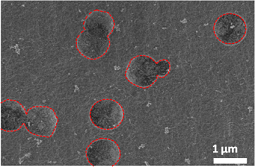
Sarmiza Elena Stanca
Leibniz Institute of Photonic Technology, Germany
Title: Noble metal nanostructures
Time : 16:40-17:00

Biography:
S E Stanca has her expertise in electrochemical and optical nanosensors achieved during her research activity at the EPFL Lausanne (Swiss Confederation Fellow), UCD Dublin (Marie-Curie-Fellow), UKJ Jena (Marie-Curie-Fellow), University Babes-Bolyai Cluj-Napoca, Research Centre Karlsruhe and IPHT Jena (DAAD Fellow). She is currently a Scientist at the Leibniz Institute of Photonic Technology Jena.
Abstract:
An ongoing objective in the field of nanotechnology is to create specific nanostructures by precisely engineering their physico-chemical properties such as size, shape, charge, aqua-phobicity/philicity and chemical reactivity. The distinctive properties of noble metal perpetually inspire people, leading to new and unpredictable applications. Several scientific efforts were already concentrated to achieve structures of noble metal with new optical values while preserving the electrical and thermal conductivity. In this context, the chemical and electrochemical synthesis of the sensing active metallic colloids in aqueous and non-aqueous media, and also their characterization will be detailed. The obtained noble metal blacks exhibit high purity and are described by a broad absorbance and low reflectance in the ultra violet, visible and in the infrared domain from 200 nm to 20000 nm. X-ray analysis established the purity and crystalline nature. The electron micrographs indicate that the nanostructures consist of crystals that interconnect to form porous assemblies. Particularly, it will be shown how the platinum black thin layer, electrochemically deposited on different metallic and semi-conductive substrates is influenced by the substrate materials. The characteristics of high conductivity, low reflection coupled with high specific surface could confer to the noble metal blacks’ value in catalysis and in electronics, predominantly in optical sensors.
Recent Publications:
- Stanca S E, Hänschke F, Ihring A, Zieger G, Dellith J, Kessler E, Meyer H G (2017) Chemical and electrochemical synthesis of platinum black. Scientific Reports 7: 1074.
- Stanca S E, Fritzsche W, Dellith J, Undisz A, Deckert V, Krafft C, Popp J (2015) Aqueous Black colloids of reticular nanostructured gold. Scientific Reports 5: 7899.
Ravindra Reddy Chowreddy
Norner AS, Norway
Title: Fabrication and characterization of carbon nanotube–recycled polyethylene terephthalate nanocomposites
Time : 17:00-17:20

Biography:
Ravindra Reddy Chowreddy has received MSc in Chemistry from Bangalore University, Bangalore, India in 1999 and PhD in Applied Sciences from Visvesvaraya Technological University, India in 2006. He has 4 years of Post-doctoral research experience from University of Waterloo, Canada. Currently, he is working as a Senior Researcher at Norner AS, an industrial R&D services provider in the field of plastics in Norway. His research areas of interest include polymer nanocomposites, bioplastics from the renewable sources and food co-streams.
Abstract:
Polymer nanocomposites (PNCs) containing organic and inorganic nano-fillers have attracted great interest from both academia and industry due to their unique characteristics. PNCs exhibit superior mechanical properties, lower permeability for gases, improved flame retardancy, better thermal stability, improved chemical resistance, and enhanced thermal and electrical conductivity. In the present study, recycled poly(ethylene terephthalate) (PET) nanocomposites containing multi-wall carbon nanotubes (CNTs) were prepared through melt compounding via masterbatch dilution method. The masterbatch and the nanocomposites were processed in a twin-screw extruder. The resulting PET-CNT nanocomposites were characterized for rheological, thermal, mechanical and morphological properties. Incorporation of CNTs into recycled PET at reasonably lower concentration significantly increases the viscosity. The storage modulus and loss modulus of nanocomposites was also increased with CNTs loading and which was more pronounced at lower frequencies. The incorporated CNTs in recycled PET increase the degree of crystallinity and crystallization temperature through heterogeneous nucleation. Thermal stability and glass transition temperature of PET-CNT nanocomposites was slightly higher than the reference recycled PET. The tensile properties of PET-CNT nanocomposites increased even at low concentrations of CNTs. Morphological investigation through scanning electron microscopy indicated homogeneous dispersion of CNTs at lower concentrations. At higher concentrations, the CNTs tend to agglomerate due to nanotube-nanotube interactions.
Marta Prada
University of Hamburg, Germany
Title: Adatom’s Berry phase as a classification toolkit and responsible for enhanced lifetimes of degenerated ground states
Time : 17:20-17:40

Biography:
Marta Prada is a Theoretical Physicist at the Institute for Theoretical Physics. She obtained her PhD degree in 2006 from the University of Leeds. She did her first Post-doctoral degree from the University of Purdue with Professor Klimeck, on the topic of large scale nano-electronic simulators, and then moved as a Lecturer and Research Assistant to the University of Madison-Wisconsin, in the Quantum Computing Group. Currently, she works at the University of Hamburg, Germany since 2013 and is involved in a number of projects: correlations in ultra-cold atom systems, effects of interactions in topological systems, bulk band-edge correspondence in graphene-like systems and nano-electromechanical systems.
Abstract:
In the early 80’s, Berry discovered an intriguing, non-integrable phase depending only on the geometry of the parametric space. This phase, which had been overlooked for decades, provided a deep insight on the geometric structure of quantum mechanics, resulting in various observable effects. The concept of the Berry phase is a central unifying concept in quantum mechanics, shedding light onto a broad range of phenomena such as the Aharonov-Bohm effect, the quantum and the anomalous Hall effect, etc. Moreover, geometric or Berry phases nowadays represent the most robust resource for storing and processing quantum information. In this work, we derive the general form of the non-trivial geometric phase resulting from the unique combination of point group and time reversal symmetries. This phase arises e.g. when a magnetic adatom is adsorbed on a non- magnetic Cn symmetric crystal surface, where n denotes the fold of the principal axis. This phase dictates non-trivial spin dynamics, bearing enhanced lifetimes of prepared states. In addition, the energetic ordering and the relevant quantum numbers of the eigenstates are entirely determined by this quantity. Moreover, this phase allows to conveniently predict the protection mechanism of any prepared state, shedding light onto a large number of experiments and allowing a classification scheme. Owing to its robustness this geometric phase also has great relevance for a large number of applications in quantum computing, where topologically protected states bearing long relaxation times are highly desired.
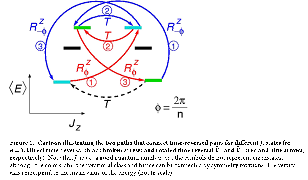
Recent Publications:
- Prada M (2017) The geometric phase of Zn- and T-symmetric nanomagnets as a classification toolkit. Nature Sci. Rep. 7: 46614.
Angelica Chiodoni
Italian Institute of Technology, Italy
Title: Nanostructured MnxOy as catalyst for oxygen reduction reaction
Time : 17:40-18:00

Biography:
Angelica Chiodoni is Researcher at the Center for Sustainable Future Technologies of the Istituto Italiano di Tecnologia (IIT). She graduated in Materials Science at the Universita’ degli Studi di Torino and received her Ph.D. in Physics at the Politecnico di Torino. Her research activity is mainly focused on the use of the electron microscopy as a powerful tool for material characterizations. She is the coordinator of the Electron Microscopy facility of the Center, including a Dual Beam and a 200 KV Transmission Electron Microscope. She is currently involved in the Advanced Materials Division, with interest on the development of catalysts for the photo/electrochemical CO2 reduction and conversion.
Abstract:
In the framework of the growing concerns about global warming, the development of new and clean energy resources represents one of the major scientific challenges. In particular, in fuel cells and metal-air batteries, the electrochemical Oxygen Reduction Reaction (ORR) occurring at the cathode is one of the key limits for their further development and requires electrocatalysts to increase the reaction efficiency. Manganese oxides are among the most considered non-precious metal-based catalysts due to their low cost, relatively high abundance, low environmental impact and considerable electrocatalytic activity. In this work we present nanostructured manganese oxides in the form of xerogels (obtained by means of the sol-gel plus freeze- drying techniques) and in the form of nanofibers (obtained by means of the electrospinning technique) as catalysts for the Oxygen Reduction Reaction. They were synthesized by employing manganese acetate as the Mn source and by employing environmental friendly (water is the used solvent) templating agents, such as agar and polyethylene oxide, for xerogels and nanofibers respectively. To investigate the oxidation process forming the manganese oxides species, structural and morphological characterizations as in-situ X-ray diffraction, field emission scanning electron microscopy (FESEM) and transmission electron microscopy (TEM) were performed on both the nanostructures. The obtained materials were composed by Mn3O4, Mn2O3, or a mix of both, depending on the calcination temperature. The catalytic performance of the two nanostructured catalysts were characterized by means of the rotating ring disk electrode technique by using 4-electrodes measurements. Both xerogels and nanofibers showed good performances for the oxygen reduction reaction, with n values between 3.5 and 3.7, meaning a predominant 4-electrons reduction pathway.
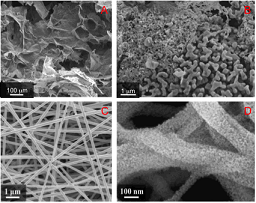
- Session 1: Electronic, Optical and Magnetic Materials
Location: Olimpica 1
Session Introduction
Henri Jaffres
Scientific Research National Center (CNRS), France
Title: Electrical spin injection and detection in molybdenum disulfide multilayer channel
Time : 09:00-09:20

Biography:
Henri Jaffrès completed his PhD in the Physics Department of the National Institute of Applied Sciences (INSA) - University Toulouse III, France, in 1999. He joined the Joint Physics Unit CNRS-Thales, France as a Post-doctoral Fellow (2000–2001). His work focuses on spintronics, spin injection, spin transport, and spin transfer in semiconductor spintronics devices with electrical and optical detection in III-V heterostructures, as well as spin-hall effect and spin-pumping in group IV semiconductors.
Abstract:
Molybdenum disulfide has recently emerged as a promising two- dimensional semiconducting material for nano-electronic and spintronic applications. However, the demonstration of an electron spin transport through ferromagnetic source and drain connecting a semiconducting MoS2 channel remains challenging. Here, the author will present the experimental evidence of the electrical spin-injection and spin-detection in the conduction band of a multilayer MoS2 semiconducting channel using a two terminal spin-valve configuration geometry. A magnetoresistance around 1% have been observed through a 450 nm long, 6 monolayer thick MoS2 channel with a Co/MgO tunneling spin injector and detector. It is found that keeping a good balance between the interface resistance and channel resistance is mandatory for the observation of the two-terminal magnetoresistance. Moreover, the electron spin-relaxation is found to be greatly suppressed in the multilayer MoS2 channel with an in-plane magnetization and spin-polarization. The long spin-diffusion length (approximately 235 nm) could open a new avenue for spintronic applications using multilayer transition metal dichalcogenides. In this talk, corollary to experiments, I will particularly emphasize on the mechanism of spin-injection at interfaces between a spin-polarized tunnel junction and a semiconductor channel, homogeneous or not. The latter can be composed of several regions, uniformly doped or depleted to form a Schottky contact and possibly location of a conduction made by hopping. I will extend the conditions for spin-injection from a spin- polarized ferromagnetic source into a Schottky contact on the ground of the experiments observed with success on MoS2 systems.
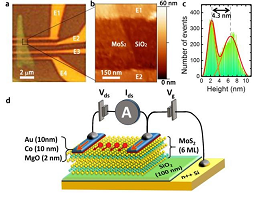
Figure 1: Multilayer MoS2-based lateral spin-valve device. (a) Optical image of the device with the multilayer MoS2 flake on 100 nm SiO2/Si(nþ þ) substrate, the E1, E2, E3 and E4 indicate the four Au/Co/MgO electrodes. (b, c) AFM measurement (in tapping mode) focused on the MoS2 channel between E1 and E2 electrodes. The thickness of MoS2 is determined by the Gaussian distribution of pixel height in the square region in b. (d) Schematics of the lateral spin-valve device. The multilayer MoS2 serves as a spin transport channel, and two Au/Co/MgO electrodes are used to inject spin (Vds) and measure the current (Ids). A back-gate voltage (Vg) between the substrate and one top contact is used to modulate the carrier density in MoS2.
Recent Publications:
1.A Fert, J M George, H Jaffrès, R Mattana (2007) Title. IEEE transactions on electron devices 54:5.
2.A Fert, H Jaffrès (2001) Title. Phys. Rev. B 64:184420.
3.M Tran, H Jaffrès, C Deranlot, J M George, A Fert, A Miard, A Lemaître (2009) Title. Phys. Rev. Lett. 102: 036601.
Vladimir A Gavrichkov
Federal Research Center KSC, Russia
Title: Microscopic background in metal-insulator criterion for doped Mott-Hubbard materials
Time : 09:20-09:40

Biography:
Vladimir A Gavrichkov has experience in the study of the electronic structure of strongly correlated materials: iron borates with spin S=5/2, manganites (S=2) and cuprates (S=1/2). His metal-insulator criterion creates a new conception of the dielectric state in doped materials with translational symmetry. He obtained the criterion as a result of the latest research in the field of many-electron effects in the electronic structure and exchange interaction of these materials. The approach is based on Hubbard’s quasiparticle picture and Wilson’s view on nature of the metal/dielectric state in itinerant electron system.
Abstract:
Statement of the Problem: The purpose of this study is to construct a metal–insulator criterion based on Wilson's ideas concerning a system of itinerant electrons in the analytical form for the doped Mott–Hubbard materials and also to associate a microscopic background of criterion with real properties of these materials.
Methodology & Theoretical Orientation: For our purposes, it is convenient to start with Lehmann's representation for the Green's function of the intra-cell Hamiltonian with respect to the family of single-particle operators and their matrix elements in the basis of eigenstates of (S and M are the spin and spin projection of the many-electron cell eigenstate), where index i runs over ,and states in the different sectors of configuration space in Figure from the work.
Findings: By following this approach, one obtains a simple metal– insulator criterion, which is characterized by the condition: the number of first removal electron (frs) states (-insulator) or (-metal) irrespective of the doped hole concentration x.
Conclusion & Significance: We suggest a non-adiabatic origin of the forbidden frs states and Ham’s effect for their matrix elements as the probable reasons for insulator state of the doped materials with translational symmetry.
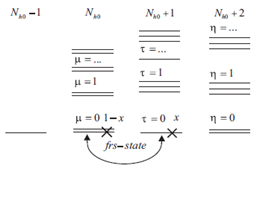
Recent Publications:
1. Gavrichkov V A (2015) A simple metal-insulator criterion for the doped Mott-Hubbard materials. Sol. St. Comm. 208: 11-14.
2. Ovchinnikov S G, Gavrichkov V A, Korshunov M M, Shneyder E I (2012) LDA+GTB method for band structure calculations in the strongly correlated materials. Solid-State Sciences 171: 143-171.
3.Gavrichkov V A, Korshunov M M, Ovchinnikov S G, Shneyder E I, Orlov Yu S, Nekrasov I A, Pchelkina Z V (2012) Сuprates, manganites and cobaltites: multielectron approach to the band structure. Modern Physics Letters B26: 1230016.
4.Gavrichkov V A, Ovchinnikov S G, Pchelkina Z V, Nekrasov I (2010) Quasiparticles in CMR oxides in para- and ferromagnetic phases. Journal of Physics 200: 012046(1-4).
Rita Massa
University Naples Federico II, Italy
Title: An electromagnetic-thermal model for heating patterns prediction of microwave treated palm to contrast the Red Palm Weevil
Time : 09:40-10:00

Biography:
Rita Massa is professor of electromagnetic fields at the Department of Physics “Ettore Pancini” at the University of Naples Federico II, where she is the chief of the NIR-Billy (Non Ionizing Radiation –Biolectromagnetic) Laboratory. She as her expertise in the interactions of electromagnetic fields (overall radiofrequency and microwaves)with materials. Her research interests are biological effects of electromagnetic fields, electromagnetic dosimetry, electromagnetic fields exposure assessment (both numerical and experimental), therapeutic and industrial applications of microwaves, high power microwave applications, nondestructive testing of materials. The approach is basically experimental. The purpose applications focused on human health (biological systems) and monitoring (diagnostics) and control of materials and processes.
Abstract:
The invasive red palm weevil (RPW), Rhynchophorus ferrugineus Olivier is one of the most destructive pests of palms in the world. In the Mediterranean Basin, it spread slowly until 2004 but nowadays it can be found in almost all Mediterranean countries and it is particularly destructive for Phoenix canariensis palms. In the integrated pest management strategy, adopted to combat this pest, there is a considerable interest toward solutions able to control the pest with a minimum impact on the environment. Microwave/dielectric heating (MDH) is a technology that could meet this requirement by increasing the temperature of the insect until it dies, or its development capability is reduced, without damage the palm tissues. MDH is applied to insect control in food and we have shown its feasibility on infested palms. Heating patterns strongly depend on both electromagnetic and thermal properties that are related to the physiology of the plant. Results of dielectric spectroscopy and calorimetric measurements, carried out during microwave exposure of a healthy living palm, were employed to develop a simple electromagnetic-thermal code. It allows to predict the thickness of the annular area in “living” palms wherein the temperature reaches the lethal temperature for the insect, and how long it should stay in order to have a high probability that the treatment is successful without damaging the palm core that is the most relevant area for the life of the palm itself. The heating patterns predicted were found to agree well with the experimental and numerical results (obtained with acommercial software). It can be concluded that, MDH is a very promising and eco-compatible solution for contrasting the diffusion of RPW. The tool developed can be easily used by non-skilled operators for setting the parameters that can better guarantee the efï¬cacy of the treatment.
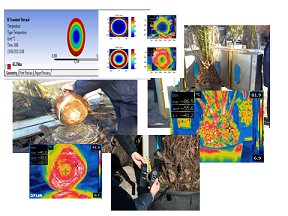
Figure 1: Electromagnetic-thermal model and experimental validation of a microwave treated palm.
Recent Publications :
1. Massa R, Panariello G, Pinchera D, Schettino F, Caprio E, Griffo R, Migliore M D (2017) Experimental and numerical evaluations on palm microwave heating for red palm weevil pest control. Scientific Reports 7: 45299.
2. Massa R, Migliore M D, Panariello G, Pinchera D, Schettino F, Caprio E, Griffo R (2014) Wide band permittivity measurements of palm (P. canariensis) and Rhynchophorus ferrugineus for RF pest control. J. Microwave Power and Electron Energy 48(3): 158-169.
3. Massa R, Caprio E, De Sanctis M, Griffo R, Migliore M D, Panariello G, Pinchera, Spigno P (2011) Microwave treatment for pest control: The case of Rhynchophorus ferrugineus in Phoenix canariensis. EPPO Bulletin 41(2): 128-135.
Satoshi Fujii
National Institute of Technology, Okinawa College, Japan
Title: Study on chemical reaction under microwave irradiation
Time : 10:00-10:20

Biography:
Satoshi Fujii received his BS and MS degrees in Material Science from Tsukuba University, Ibaragi, Japan, in 1985 and 1987, respectively. He received his PhD degree in Material Engineering from Kyoto Institute of Technology in 2007. In 1987, he joined Sumitomo Electric Industries and was involved in research on GaAs ICs in Opto-electronics Laboratories. Since 1992, he has been working on diamond SAW devices at the Itami Research Laboratories, Nagoya University. In 2004, he moved to the Advanced Technology Development Center, Seiko-Epson Corp., in order to study diamond SAW devices and related modules. In 2015, he joined the Faculty of the National Institute of Technology, Okinawa as a Professor.
Abstract:
Chemical reactions performed under microwave irradiation often demonstrate high reaction rates and high selectivities, which allows for more compact reactors and more energy-efficient processes than conventional heating methods. Consequently, our group has discovered a new chemical reaction, performed with a self-processing microwave irradiation source. We have proposed a solid-state microwave source with an ultra-precise oscillator and/or injection-locked magnetron that can be used to achieve reproducible results in microwave-mediated chemical reactions. These microwave effects can be classified into two types: thermal effects, which arise from the temperature increase caused by microwaves, and non-thermal effects, which are attributed to the interactions between the substances and the oscillating electromagnetic fields of the microwaves. For thermal effects, we have demonstrated that a silver-nanoparticle-coated polyimide thin film, which was synthesized via a microwave–mediated sintering process, displayed conductivity seven-fold greater than that of the film formed in a conventional furnace. We have developed a novel microwave-driven Pidgeon process to produce Mg metal with less energy consumption and no direct CO2 emission. An antenna structure, consisting of dolomite as the Mg source and a ferrosilicon antenna as the reductant, was used both to confine the microwave energy emitted from the magnetron in the microwave oven and to produce a practical amount of pure Mg metal. This microwave Pidgeon process with an antenna configuration made it possible to produce Mg with an energy consumption of 58.6 GJ/t, corresponding to 68.6% reduction compared to the conventional method. For non-thermal effects, we demonstrated the microwave-enhanced electrolysis of water to generate O2 using a α-Fe2O3 electrode with induction by pulsed microwave irradiation under a constantly applied potential.
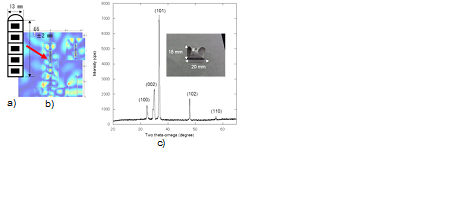
Figure 1: a) Antenna structure and b) Electric field distribution in the applicator, and c) X-ray diffraction and photo image of Mg obtained by microwave Pidgeon method.
Recent Publications:
1.Fujii S (2014) Chemical reaction under highly precise microwave irradiation. Journal of Microwave Power and Electromagnetic Energy 48: 89-103.
2.Fujii S (2016) Injection-locked magnetron using a cross-domain analyzer. IEEE Microwave and Wireless Components Letters 26: 966-968.
3.Fujii S (2015) Microwave sintering of Ag-nanoparticle thin films on a polyimide substrate. AIP Advances 5: 1-11.
4.Wada Y, Fujii S (2017) Smelting magnesium metal using a microwave Pidgeon method. Sci. Rep. 7: 46512.
5. Kishimoto F, Fujii S (2016) Enhancement of anodic current attributed to oxygen evolution onα-Fe2O3 electrode by microwave oscillating electric field. Sci. Rep. 6: 35554.
Gaspare Varvaro
ISM-CNR, Italy
Title: L10-FePt based systems for ultra high-density magnetic recording
Time : 10:20-10:40

Biography:
Gaspare Varvaro has done his PhD in Material Science 2007, University “La Sapienza” of Roma, Italy. He works as a CNR Researcher since 2010. He is a member of the Nanostructured Magnetic Material Lab (ISM – CNR) and Head of the Thin Film Deposition Lab since 2015. His interests span from the fabrication to the characterization of magnetic and magneto-transport properties and their correlation with morpho-structural properties of nanostructured magnetic materials including single-phase, magnetic composites and hybrid/multifunctional systems (thin films, multilayers, nanoparticles and nano-patterned systems) for fundamental studies and applications (information storage, energy, sensors and biomedicine). His research activity is witnessed by more than 40 papers on ISI journals and conference proceedings and 2 book chapters. He is co-editor of a book titled “Ultra-High-Density Magnetic Recording: Storage Materials and Media Designs”.
Abstract:
The demand for digital storage devices is continuously growing in response to the extraordinary increase of the volume of data created worldwide, which would reach the value of 40 zettabytes in 2020. Among the different storage devices currently available, the hard disk drive (HDD), based on the magnetic recording technology, remains the most convenient (cost/GB 0.02 $) and diffusive devise (~400 millions of units sold in 2016) for massive digital data storage. Currently available HDDs using CoCrPt:SiO2 granular thin films with perpendicular magnetic anisotropy are reaching their physical limit (~1 Tbit/in2 recording density) due to thermal fluctuations that hinder a further reduction of in-plane grain size (to 4–5 nm) needed to scale down the bit size. L10-FePtX alloy is currently considered the most promising candidate for future recording media with areal densities above 1 Tbit/in2 thanks to its high magneto-crystalline anisotropy, which enables it to be thermally stable even at grain sizes down to 3 nm. However, its huge anisotropy implies an increase of the switching field, which cannot be afforded by current available write heads. The writability and thermal stability requirements can be simultaneously addressed by using exchange coupled composite systems, combining two or multiphase magnetic hard and soft materials, where the hard phase provides thermal stability and the soft phase reduces the switching field. An alternative approach involves the use of so-called bit patterned media, which consist of an ordered two-dimensional array of individual magnetic nanostructures with perpendicular anisotropy, each of them representing one bit of information, obtained by nanolithography and/or self-assembly techniques. This communication reports on the fabrication and physical properties of FePtX-based thin films and nanoparticles of potential interest for next generation recording media based on exchange coupled composite materials and bit patterned magnetic recording technology.

Recent Publications:
1.Varvaro G, Casoli F Eds (2016) Ultra-high-density magnetic recording: Storage materials and media designs. Pan Stanford Publishing.
2.Barucca G, Speliotis Th, Giannopoulos G, Niarchos D, Rutkowski B, Czyrska-Filemonowicz A, Agostinelli E, Laureti S, Testa A M, Varvaro G (2017) Magnetic anisotropy phase-graded A1/L10-FePt films on amorphous glass substrates. Mat. Design 123: 147.
3.Varvaro G, Laureti S, Fiorani D (2014) L10 FePt-based thin films for future perpendicular magnetic recording media. JMMM 368: 415.
4.Faustini M, Capobianchi A, Varvaro G, Grosso D (2012) highly controlled dip-coating deposition of fct FePt nanoparticles from layered salt precursor into nanostructured thin films: An easy way to tune magnetic and optical properties. Chem. Mater. 24: 1072.
Szymon Chorazy
Jagiellonian University, Poland
Title: Photoluminescent crystalline magnetic materials based on trivalent lanthanide ions and polycyanidometallates
Time : 10:40-11:00

Biography:
Szymon Chorazy is an Assistant Professor in Inorganic Molecular Materials Group at the Jagiellonian University in Krakow, Poland, and Collaborative Researcher in Solid State Physical Chemistry Group at The University of Tokyo, Japan. He has received his PhD from Jagiellonian University under the supervision of Professor Barbara Sieklucka and Professor Shin-ichiOhkoshi from the University of Tokyo. He joined as a Project Assistant Professor in the Department of Chemistry, School of Science, University of Tokyo. Later, he joined Professor Barbara Sieklucka’s Group working as an Assistant Professor. His research interests cover the design, preparation and physico-chemical characterization of novel functional magnetic materials revealing various optical, magneto-optical, and phase transition properties.
Abstract:
Photo- and electroluminescence induced in solid-state materials arouse a remarkable interest due to a number of applications in light-emitting devices, optical communication, tunable laser systems, low-energy scintillation, energy conversion, chemical sensing, and bioimaging. Thus, there is a strong need to design and prepare new functional materials exhibiting efficient light-emitting functionalities, including white-light emission, near-infrared phosphorescence, multi-colored switchable emission, or up-conversion luminescence. Another exciting idea is to synthesize multifunctional luminescent materials that combine strong photoluminescence with other physical properties. In this regard, the conjunction of magnetic and emission phenomena are particularly attractive due to the expected cooperative effects, and the possibility of tuning light emission by a magnetic field. We present two main strategies toward bifunctional photoluminescent and magnetic materials, both realized within the family of heterobimetallic coordination polymers built of polycyanidometallates, [MV(CN)8]3-(M=Mo, W) and [MIII(CN)6]3- (M=Cr, Co), which serve as metalloligands to complexes of trivalent lanthanide ions with selected organic molecules. In the first approach, we present the synthetic route toward emissive molecule-based ferromagnets based on bimetallic octacyanido-bridged Tb-W and Tb-Mo, and hexacyanido-bridged Nd-Cr assemblies. They combine a long-range ferromagnetic ordering with the visible or near-infrared emission, depending on the applied lanthanide (3+) ions. Our second approach explores a strong magnetic anisotropy of Dy3 complexes leading to the effect of slow magnetic relaxation, which is named a single-molecule magnet (SMM) behavior. We embedded the Dy3 SMMs into bimetallic cyanido-bridged Dy-Co coordination networks producing the magneto-luminescent materials combining significant magnetic anisotropy with white light emission, or multi-colored visible emission tunable by the excitation light.

Recent Publications:
1.Chorazy S, Rams M, Nakabayashi K, Sieklucka B, Ohkoshi S (2016) White light emissive Dy3 single-molecule magnets sensitized by diamagnetic [Co3(CN)6]3- Linkers. Chemistry – A European Journal 22: 7371-7375.
2.Chorazy S, Wang J, Ohkoshi S (2016) Yellow to greenish-blue color-tunable photoluminescence and 4f-centered slow magnetic relaxation in a cyanido-bridged Dy3(4-hydroxypyridine)-Co3 layered material. Chemical Communications 52: 107595-10798.
3.Chorazy S, Sieklucka B, Ohkoshi S (2016) Near-infrared photoluminescence in hexacyanido-bridged Nd-Cr layered ferromagnet. Crystal Growth & Design 16: 4918-4925.
4.Chorazy S, Arczynski M, Nakabayashi K, Sieklucka B, Ohkoshi S (2015) Visible to near-infrared emission from Ln3(Bis-oxazoline)-[MoV(CN)8] (Ln=Ce-Yb) magnetic coordination polymers showing unusual lanthanide-dependent sliding of cyanido-bridged layers. Inorganic Chemistry 54: 4724-4736.
5.Chorazy S, Nakabayashi K, Ohkoshi S, Sieklucka B (2014) Green to red luminescence switchable by excitation light in cyanido-bridged Tb3-WVFerromagnet. Chemistry of Materials 26: 4072-4075.
Masato Kotsugi
Tokyo University of Science, Japan
Title: Rare-metal-free super magnet L10-type FeNi ordered alloy
Time : 11:15-11:35

Biography:
M Kotsugi has his expertise in surface and interface magnetism based on molecular beam epitaxy and synchrotron radiation. He received his PhD based on surface electron diffraction thesis from Osaka University. He joined Max Planck Institute in 2001 as a Post-doctorate, where he worked in the field of Multilayer Magnetism. He is currently heading the Electronic Solid State Engineering Laboratory in Tokyo University of Science.
Abstract:
For the realization of low carbon society, development of advanced magnetic materials has been rapidly progressed in this decade. Especially, rare-metal-free-super magnet is key material of electric vehicles and renewable energy, to increase conversion efficiency and reduce environmental load. L10-type FeNi(Co) order alloy is a candidate of such advanced magnetic material. L10-FeNi is described as an ordered alloy, in which Fe and Ni single atomic layers are alternately stacked along the c-axis direction. Its predicted magnetic anisotropy energy is 1×107 erg/cc and magnetic moment is 1200 emu/cc. Magnetic anisotropy is known to correlate strongly with lattice structure and electronic structure. However, the study of local magnetic moment and surface morphology has not been satisfactorily carried out so far.  In this work, we report: (1) the construction of pulsed-laser-deposition (PLD) system, (2) fabrication of L10-FeNi(Co) by alternate monoatomic layer deposition and (3) macroscopic and microscopic characterization of L10-FeNi(Co) thin film. We examine the perpendicular magnetization by using super quantum interference device (SQUID) and photoemission electron microscope (PEEM). Magnetization curve was measured using SQUID. Result of SQUID shows that saturation magnetization (Ms) of 265 emu/cc, out-of-plane magnetization is greater than in-plane magnetization therefore; easy axis of magnetization is out-of-plane. Magnetic domain observation was carried out by photoelectron emission microscope utilizing X-ray magnetic circular dichroism (XMCD-PEEM) at soft X-ray undulator beamline BL17SU of SPring-8. Results of XMCD shows maze-pattern was confirmed (Fig.1). This behavior is clearly different from magnetic domain with B2-FeCo with in-plane magnetization. We suggest that FeCo film obtains perpendicular magnetization with spontaneous magnetization.
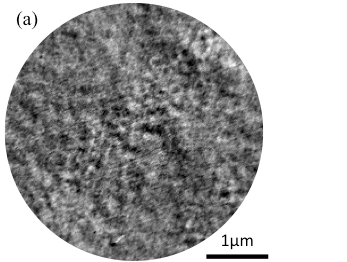
Tokiyoshi Matsuda
Ryukoku University, Japan
Title: Rare-metal-free high-performance Ga-Sn-O thin film transistor
Time : 11:35-11:55

Biography:
Tokiyoshi Matsuda has his expertise in fabricating amorphous oxide semiconductor materials, evaluation of defects in the oxide semiconductor, and its TFT application. He proposed the model of oxygen vacancy in IGZO. Novel material of Ga-Sn-O was fabricated to avoid the use of rare metal material of In, and Zn which may cause the device instability. These oxide semiconductors are suitable for use in novel devices not only next-generation displays, but also power devices and artificial intelligence devices such as neural networks.
Abstract:
Oxide semiconductors have been investigated as channel layers for thin film transistors (TFTs) which enable next-generation devices such as high-resolution liquid crystal displays (LCDs), organic light emitting diode (OLED) displays, flexible electronics, and innovative devices. Here, high-performance and stable Ga-Sn-O (GTO) TFTs were demonstrated for the first time without the use of rare metals such as In. Substituting Sn for In is a reasonable countermeasure for avoiding the use of rare earth metals. Moreover, In and Sn have similar electronic structures and electrical properties. The GTO TFT was fabricated on a Si wafer with thermal oxide. The GTO thin films were deposited using radiofrequency (RF) magnetron sputtering. A high field effect mobility of 29.9 cm2/Vs was achieved as shown in Figure 1. The stability of the GTO TFTs was examined under bias, temperature, and light illumination conditions. The electrical behavior of the GTO TFTs was more stable than that of In-Ga-Zn-O (IGZO) TFTs, which was attributed to the elimination of weak Zn-O bonds. High field effect mobility TFT with a low S factor was prepared using GTO, where the rare earth In was replaced by Sn. The stability of the GTO TFT without a passivation film under various accelerated operating conditions was significantly higher than that of equivalent IGZO TFTs. Although we compared the IGZO and GTO TFTs fabricated in our laboratory just for evaluation of the materials themselves, because TFT characteristics are influenced by the treatment of backchannel such as passivation materials and methods, and surface treatment the effective treatments for IGZO TFT can also be effective for GTO TFT. We propose such GTO TFTs as key devices suitable for use in next-generation technologies such as displays, power devices, and artificial intelligence devices such as neural networks.
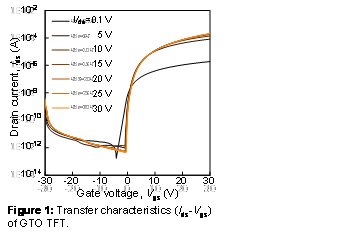
Recent Publications
1. Tokiyoshi M, Kenta U, Yuta K, Daiki N, Mutsumi K (2017) Rare-metal-free high-performance Ga-Sn-O thin film transistor. Scientific Reports 7: 44326.
2.Mutsumi K, Takaaki M, Akito Y, Tokiyoshi M, Tokuro O, Koji A, Chih-Che K (2016) Hall effect in thin-film transistor. IEEE Transactions on Electron Devices 63: 3335 – 3337.
3.Tokiyoshi M, Mutsumi K (2015) Comparison of defects in crystalline oxide semiconductor materials by electron spin resonance. Journal of Vacuum Science and Technology A 33: 020601.
Luca Fausto Tocchio
International School for Advanced Studies, Italy
Title: Ferroelectricity and magnetism in the organic charge transfer salts κ-(ET)2X
Time : 11:55-12:15

Biography:
Luca F Tocchio is a Researcher at the Institute for Condensed Matter Physics and Complex Systems of Politecnico di Torino. He has worked as a Post-doctoral fellow at the University of Frankfurt and at the International School for Advanced Studies (SISSA) in Trieste, where he also did his PhD. He works on numerical Monte Carlo simulations of models for strongly correlated electron systems, aiming to study topics like high-temperature superconductivity, spin-liquid phases, interplay between charge and magnetic degrees of freedom. He is also interested in methodological improvements of variational wave functions to better describe correlated electron systems.
Abstract:
The molecular conductors κ-(ET)2X, where ET denotes an organic molecule and X is an anion, exhibit electronic ferroelectricity, where charge order breaks inversion symmetry, accompanied by the onset of magnetic order. These materials can be modeled by a 3/4 filled extended Hubbard model on a two-orbital anisotropic triangular lattice (see figure), where the molecular degrees of freedom are explicitly taken into account. The model is theoretically investigated by the variational Monte Carlo method. By studying the effect of the competing inter-site Coulomb interactions, we determine charge order patterns and how these charge orders generate emergent magnetic order. In particular, we find three charge ordered phases, namely, a nonpolar insulating one, a polar insulating one, leading to ferroelectricity, and a charge-ordered metallic phase with a 3-fold geometry. The charge ordered phases are accompanied by the presence of magnetic order that is more enhanced within the polar phase.
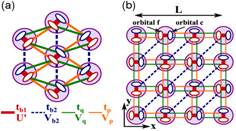
Recent Publications
1.R Kaneko, L F Tocchio, R Valentí, C Gros (2016) Emergent lattices with geometrical frustration in doped extended Hubbard models, Phys. Rev. B 94, 195111.
2.E Ghorbani, L F Tocchio, F Becca (2016) Variational wave functions for the S=1/2 Heisenberg model on the anisotropic triangular lattice: Spin liquids and spiral orders, Phys. Rev. B 93: 085111.
3.L F Tocchio, C Gros, X F Zhang, S Eggert (2014) Phase diagram of the triangular extended Hubbard model. Phys. Rev. Lett. 113: 246405.
4. L F Tocchio, H Feldner, F Becca, R Valentí, C Gros (2013) Spin-liquid versus spiral-order phases in the anisotropic triangular lattice. Phys. Rev. B 87: 035143.
Mina Yoon
University of Tennessee, USA
Title: Materials by design for thermodynamically stable electrides
Time : 12:15-12:35

Biography:
Mina Yoon received her PhD degree in Theoretical Condensed Matter Physics in 2004, from Michigan State University. She is a Research Scientist at ORNL and a Joint Professor of Physics at University of Tennessee, Knoxville. The primary focus of her research lies in the fundamental understanding of growth mechanisms, novel properties, functionalization, and potential technological applications of surface-based and low-dimensional materials. Especially, her interest is in utilizing these materials as light, environmentally friendly, and efficient energy storage/generation and optoelectronic application by making use of their unique low-dimensional properties. Her theoretical approach ranges from atomistic modeling by first-principles quantum mechanical approaches and many-body potential approaches, to continuum elasticity theory and phenomenological modeling.
Abstract:
Two-dimensional (2D) electrides, emerging as a new type of layered material whose electrons are confined in interlayer spaces instead of atomic proximities, are receiving interest for their high performance in various optoelectronics and catalytic applications. A realization of electrides containing anionic electrons has been a great challenge because of their thermodynamic stability. For example, experimentally, only a couple of layered nitrides and carbides have been identified as 2D electrides. Here, we report new thermodynamically stable low-dimensional (1D and 2D) electrides by using first-principle global structure optimization method, phonon spectrum analysis, and molecular dynamics simulation. The method was applied to binary compounds consisting of alkaline-earth elements as cations and group VA, VIA, or VIIA nonmetal elements as anions, and further extended to less than ~100 K materials in databases. We demonstrated a new avenue to discover new electrides and provide new design principles, which will significantly boost the discovery of this new class of material with great technical application.
Recent Publications:
1.W Ming, M Yoon, M H Du, F Liu, K Lee, S W Kim (2016) Two-dimensional electrides predicted by global structure optimization. J. Am. Chem. Soc. 138: 15336.
2.Mahjouri Samani Masoud et al. (2016) Tailoring vacancies far beyond intrinsic levels changes the carrier type in monolayer MoSe2-x crystals vacancy induced anomalies in optical and electric properties of se-deficient MoSe2 monolayers beyond intrinsic levels. Nano Lett. 16: 5213.
3.Zhequan Yan, Liang Chen, Mina Yoon, Satish Kumar (2016) Phonon transport at the interfaces of vertically stacked graphene and hexagonal boron nitride heterostructures. Nanoscale 8: 4037.
4.Bing Huang, Mina Yoon, Bobby G Sumpter, Su-Huai Wei, Feng Liu (2015) Alloy engineering of defect properties in semiconductors: suppression of deep levels in 2D transition-metal dichalcogenides. Phys. Rev. Lett. 115: 126806.
5.S R Wagner, B Huang, C Park, J Feng, M Yoon, P Zhang (2015) Growth of metal phthalocyanine on deactivated semi-conducting surfaces steered by selective orbital coupling. Phys. Rev. Lett. 115: 096101.
Yuma Nakamura
Tsinghua University, China
Title: Intrinsic charge transport in stanene: Role of buckling and electron-phonon coupling
Time : 12:35-12:50

Biography:
Yuma Nakamura is now pursuing two Master degrees in the Department of Chemistry, Tsinghua University, China and Department of Physics, Tohoku University, Japan in double degree program. He received his BSc (2015) in the Department of Physics, Tohoku University. He has worked as a Reviewer of peer reviewed Journal of Material Research. His research interest covers computational chemistry, two-dimensional materials, and charge and spin transport phenomena. He has his expertise in density functional theory (DFT) and density functional theory (DFPT) for simulating material property.
Abstract:
Among two-dimensional materials, group IV elemental sheets such as graphene, silicene, germanene and stanene have been intensively investigated using first principles calculation. We look at the intrinsic carrier mobility for stanene, or the tin-monolayer, using Boltzmann transport equation coupled with density functional perturbation theory plus Wannier interpolation approximation to consider electron scattering with all the phonon branches with dispersion contribution. It is found that the conventional deformation potential (DP) approach which worked well for many layered materials, can well overestimate the carrier mobility in stanene because the buckled structure allows more types of electron-phonon scattering, such as acoustic flexural mode. DP theory assumed that only longitudinal acoustic phonon in long wavelength limit (|q|∼0) contributes to the charge relaxation process. In this work, we calculate all phonon modes, such as out-of-plane acoustic mode, transverse acoustic mode, and optical counterparts, in addition to longitudinal acoustic mode, plus dispersion effects and we investigate the intrinsic carrier mobility, in comparison with the DP theory. We find that the intrinsic carrier mobility could be as high as 2~3x106 cm2 V−1 s−1 by DP theory but becomes only 2~3x103 cm2 V−1 s−1 by the full evaluation of electron-phonon coupling. It is found that the intervalley scattering process in acoustic out-of-plane and transverse mode, which DP ignored dominate the carrier relaxation.
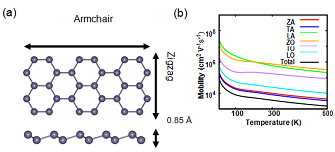
Recent Publications:
1. Yuma Nakamura, Tianqi Zhao, Jinyang Xi, Wen Shi, Dong Wang, Zhigang Shuai (2017) Intrinsic Charge Transport in Stanene: Roles of Bucklings and Electron-Phonon Couplings. Computational Physics
- Session 2: Emerging Smart Materials | Materials for Energy and Environmental Sustainability
Location: Olimpica 1
Session Introduction
Tsvetanka Zheleva
US Army Research Lab, USA
Title: Materials research in energy and power for defense
Time : 13:30-13:50

Biography:
Tsvetanka S Zheleva is the Associate Chief for the Energy and Power Division at ARL. Her expertise is in the areas of Applied Physics and Materials Science. She has published her research in over 150 publications in the areas of thin film physics, semiconductor materials and devices, interface engineering, structural analysis of device heterostructures. She holds 12 patents and her work are cited over 4000 times in peer reviewed journals and patent literature.
Abstract:
The demand for improved performance, increased power and energy densities, and reduced cost, size, and weight, drive the materials research focus of the Energy and Power (E&P) programs at the US Army Research Laboratory (ARL). An overview of ARL’s relevant broad range, major programs will be presented, with emphasis on three key areas of materials research: 1) Chemical energy materials: electrochemical storage materials, materials for fuel cells, advanced battery chemistry materials, photoelectrochemistry materials; 2) Power science: WBG materials and devices, compact power materials and devices, science of thermal materials, alternative energy materials; and 3) Power integration: reliability of WBG materials and devices, integrated power/thermal device packaging. Examples from our advancements in each of the key areas employing numerous materials characterization and modeling approaches will be presented: Chemical energy materials: the development of novel “water-in-salt” electrolytes enabling high-voltage aqueous lithium-ion chemistries, derivation of the optimal substitution of the LCP achieving exceptional stability, high capacity, lower fade, and increased thermal stability; Power science: identified a transition layer at the SiC/silicon oxide interfaces of power field effect transistors relevant to their mobility parameters, development of ferrofluid-based stretchable magnetic core inductors, experimentally demonstrated and characterized mechanisms for nuclear isomer depletion that by-pass the slow nuclear decay transitions; and Power integration: identification of SiC voltage threshold instabilities leading to revised standards for device test and characterization, and others. Much of our research is performed in close collaboration with our partners from DOE and DoD labs, academia and industry. A brief summary of the various collaborative opportunities with ARL will be presented at the end.
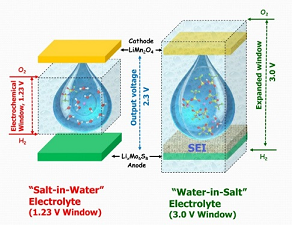
Figure 1: “Water-in-Salt” aqueous Lithium ion battery technology that could provide power, efficiency and longevity comparable to today's Lithium-ion batteries
Recent Publications:
1. J Taillon, K Gaskell, G Liu, L Feldman, S Dahr, T Zheleva, A Lelis (2015) Characterization of the oxide-semiconductor interface in 4H-SiC/SiO2 structures using TEM and XPS. Microscopy and Microanalysis 21(S3): 1537-1538.
Antonina Pirrotta
University of Palermo, Italy
Title: A new perspective for analyzing experimental tests on biomaterials
Time : 13:50-14:10

Biography:
Antonina Pirrotta has graduated in Civil Engineering from the Palermo University in 1987. She has done her PhD in Structural Engineering in 1996 and as Post-doctoral studies in 1998. In 2000, she became a Researcher, in 2001 Associate Professor and in 2016 Full Professor in the Structural Engineering department at the University of Palermo. She is the author and co-author of about 90 scientific papers dealing with the following fields: stochastic dynamics, active and passive control, stochastic differential calculus. Since 2014, she is a Professor in the Department of Mathematical Sciences, University of Liverpool, UK.
Abstract:
Given the increasing interest for the biomaterials in medical and engineering field, the objective of this talk is the theoretical and experimental analysis of the biomaterials in order to define experimental procedures and mathematical models suitable for their mechanical characterization. The biomaterials exhibit a rheological behavior intermediate between that of purely elastic materials and that of the purely viscous materials and therefore are called viscoelastic ones. In the past the “classical” models as Maxwell and Kelvin-Voigt have been used to capture viscoelastic phenomena. However, these models are not consistent to model the viscoelastic behavior of real materials, since the Maxwell type can capture the relaxation tests only and the Kelvin-Voigt the creep tests. A more realistic description of creep and/or relaxation is given by a power law function with real order exponent. As soon as we assume a power law function for creep, the constitutive law relating deformation and stress is ruled by a Riemann-Liouville fractional integral with order equal to that of the power law. In this regard, recent studies have been stressed that the most suitable model for capturing the viscoelastic behavior is the spring-pot, characterized by a fractional constitutive law. Based on the aforementioned considerations, it is apparent that the need of theoretical as well as experimental development and exploration of materials with novel physical characteristics. For instance, if the giant grass Arundo donax (AD) has to be characterized; then, attention is devoted on searching a proper model for characterizing the behavior of giant reeds. To aim at this, firstly, meticulous experimental tests have been performed in the Laboratory of structural materials of University of Palermo. Further a novel aspect of using an advanced Euler-Bernoulli model to fit experimental data of bending tests will be introduced.
Recent Publications:
1.Celauro C, Fecarotti C, Pirrotta A (2017) An extension of the fractional model for construction of asphalt binder master curve. European Journal of Environmental and Civil Engineering 21(1): 78-93.
2.Di Lorenzo S, Di Paola M, La Mantia F, Pirrotta A (2016) Non-linear viscoelastic behavior of polymer melts interpreted by fractional viscoelastic model. Meccanica, DOI: 10.1007/s11012-016-0526-8
3.Bucher C, Pirrotta A (2016) Dynamic finite element analysis of fractionally damped, structural systems in the time domain. Acta Mechanica 226(12): 3977-3990.
4.Pirrotta A, Cutrona S, Di Lorenzo S, Di Matteo A (2015) Fractional viscoelastic Timoshenko beam deflection via single equation. International Journal for Numerical Methods in Engineering 104(9): 869-886.
5.Cataldo E, Di Lorenzo S, Fiore V, Maurici M, Nicoletti F, Pirrotta A, Scaffaro R, Valenza A (2015) Bending test for capturing the vivid behavior of giant reeds, returned through a proper fractional viscoelastic model. Mechanics of Materials 89: 159-168.
Alexander Axelevitch
Holon Institute of Technology, Israel
Title: Solar cells efficiency enhancement by plasmons generation
Time : 14:10-14:30

Biography:
Alexander Axelevitch has completed his PhD in Physical Electronics from Tel-Aviv University, Tel-Aviv, Israel in the year 2002. Since 1995, he has been working at the Holon Institute of Technology (HIT). He currently leads the Nanotechnology and Microelectronics Branch of the Engineering Faculty, the Laboratory of Microelectronics and Thin Films; and works as a Senior Lecturer in Faculty of Engineering at the Holon Institute of Technology. His main research interest includes thin films deposition methods, transition metal oxides, alternative energy sources, solar cells and plasmonic effects. He has eight patents, 67 referred articles and more 150 papers presented at many scientific meetings.
Abstract:
The urgent need to develop alternative energy source focuses the attention on solar energy as a solution for this problem. The sun represents an infinite renewable energy source, thus making it most attractive. Unfortunately, the efficiency of photovoltaic (PV) converters is limited due too high electrical and optical losses. It is known that each photon can produce only one pair of charged carriers. This is one of the most important factors limiting the efficiency of solar cells. In order to increase the efficiency of PV conversion, it is necessary to increase the number of charged particles generated by absorption of a single photon. For this goal, we apply the nano-structured metal thin films which capable to form a localized surface plasmon resonance (plasmon) in each metal nanoparticle under light illumination. A plasmon represents an ensemble of free electrons (holes) oscillating coherently inside the metal nanoparticles and can be considered as a source of additional electrons obtained due polarization of these metal nanoparticles. If the nanostructured metal thin film will be embedded in the p/n junction of a diode PV structure, we may to create the conditions which help to transfer additional electrons excited by light illumination to the conductive band of the applied semiconductor. This effect has been experimentally tested in our laboratory in different PV structures containing gold and silver nanoparticles. It was found that island thin metal films deposited by sputtering and embedded into the p/n junction significantly influence of the PV structure efficiency and the type of metal defines its behavior. The power generated in the heterojunction structures In2O3-Si with the gold island interlayer increases more than to 10 times comparing with the structure without gold nanoparticles. This technology may be applied for all types of inorganic solar cells.
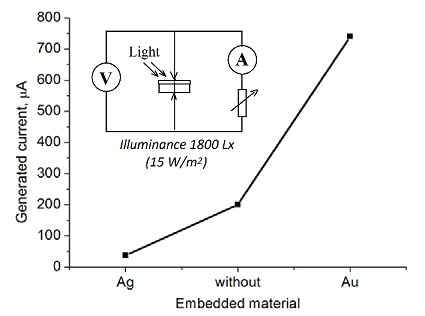
Figure 1: Comparison of the short-circuit current in different PV structures.
Recent Publications:
1.Axelevitch Alexander (2016) Application of embedded metal nanostructures for solar cells. International Journal of Renewable Energy Sources 1: 32-37.
2. Axelevitch A, Apter B (2015) In-situ investigation of optical transmittance in metal thin films. Thin Solid Films 591: 261-266.
3.Golan G, Axelevitch A, Azoulay J (2014) Properties investigation of thin films photovoltaic hetero-structures. World J. of Engineering 11(3): 233-238.
4.Axelevitch A, Gorenstein B, Golan G (2014) Application of gold nano-particles for silicon solar cells efficiency increase. Applied Surface Science 315: 523-526.
5. Axelevitch A, Palankovski V, Selberherr S, Golan G (2015) Investigation of novel silicon PV cells of a lateral type. Silicon 7(3): 283-291.
Shivani Bhardwaj Mishra
University of South Africa, South Africa
Title: Sustainable solutions for industrial waste minimization: Environmental and material applications
Time : 14:30-14:50

Biography:
Shivani Bhardwaj Mishra is working as a Professor in Nanotechnology and Water Sustainability Unit at University of South Africa. She is currently the Group Leader for the research on sol-gel science and technology, polymer ceramic composites/nanocomposites, organic-inorganic hybrid systems and its application for water research. She has an experience of more than 12 years in teaching undergraduate and post-graduate students and has supervised doctoral and master’s students. She has delivered a number of plenary, keynote, invited lectures and expert talks. She has published 81 research articles in scientifically accredited international journals and is the author of 33 book chapters
Abstract:
Waste minimization is global challenge for industries and environmental protection agencies to compete in the business through sustainable solutions. Numerous works has been done and also being carried to reduce the levels of solid and liquid waste and possibly be reutilized for various applications. Some of the work includes utilization of waste glass materials and sand for decontamination of heavy metal ions and then fabricating the residual waste into a glass. Initially sand was modified and reconstructed to suit to the composition required for glass preparation. The reconstructed san and glass fiber waste was used to uptake hexavalent chromium from electroplating waste water and then later the used up adsorbent was melted to colored glass. In another study, fly ash from local power station was used for developing pozzolanic materials for concrete production. The results show that flyash composite with cyclodextrin formed composite with competitive pozzolanic features that can be incorporated into cement for concrete production. Lignin is a natural polymer that is found in abundance in pulp and paper mill industrial waste water. This was used to develop composite material for adsorption for removal of various contaminants from waste water.
Helena Zapolsky
University of Normandy, France
Title: Quasi particle approach to study the kinetics of self-assembly in complex material
Time : 14:50-15:10

Biography:
Helena Zapolsky is a Professor of Theoretical Physics at Rouen University, Her main research interest lies in theoretical understanding of the emergence of patterns formation and kinetics of phase transformation in different type of materials. Applying different mathematical and computational approaches to diverse problems in materials science she developed an original multiscale tool to study phase transformations in materials. Recently, she proposed a novel statistical-mechanical approach to model a spontaneous self-assembling of randomly distributed atoms into pre-determined atomic structures of almost any complexity. The modeling based on the proposed theory is at atomic resolution, and addresses the time scale commensurate with a typical diffusion time, which may range from a fraction of a second to years. This method has been applied to describe the segregation at grain boundaries, self-assembly of the randomly distributed monomers into single- strand and double-stranded helixes and phase transformations in binary and ternary alloys.
Abstract:
Statement of the Problem: A self-organisation is a universal phenomenon in nature and, in particular, is highly important in materials systems. Our goal was to develop a new theory that provides a computationally effective approach to this problem.
Methodology & Theoretical Orientation: The proposed theory rests on two novel conceptual premises: (a) the introduction of interacting pseudoparticles that we call fratons that described two configurational states of each point of continuum space. The fratons are considered as a non-ideal gas whose "condensation” describes a diffusional self- assembling of atomic system, and (b) a concept of a structural cluster function describing the directions, length and strength of interatomic bonds. The latter allows us to formulate a new and simple model Hamiltonian. This model Hamiltonian provides the formation of a predetermined atomic structure and has a sufficient flexibility to describe the desired mechanic and thermodynamic properties of this structure.
Findings: The modeling based on the proposed theory is at atomic resolution, and addresses the time scale commensurate with a typical diffusion time, which may range from a fraction of a second to years. To demonstrate a potentiality and versatility of our approach, we tested its application to a self-assembling of disordered systems to three groups of systems of increasing topological complexity, viz., single component crystals (fcc, hcp and diamond structures), two component crystals (zinc-blend structure), self-assembly of the randomly distributed monomers into single-strand and double-stranded helixes and grain boundaries structure. The spontaneous self- organisation of fratons into the diamond structure.
Conclusion & Significance: The developed approach opens a way to answer numerous outstanding questions concerning the atomistic mechanisms of the formation of defects (dislocations, grain boundaries, etc.), nucleation in solid–solid transformations, folding and crystallisation of polymers, and their responses to external stimuli.

Bhavana Deore
National Research Council Canada, Canada
Title: Screen printable molecular copper ink for printed electronics
Time : 15:10-15:30

Biography:
Bhavana Deore has received her PhD in Chemistry in 1998 from Pune University, India. Subsequently, she became a Post-doctoral Fellow in the Yamaguchi University, Faculty of Engineering, Department of Applied Chemistry, Japan under the Venture Business Laboratory and Japan Society for Promotion of Science Fellowship Program. In 2002, she became a Research Associate at University of Manitoba, Department of Chemistry and then joined National Research Council Canada as a Research Officer in 2009. Her research interests include materials development like conjugated polymers, quantum dots and DNA nanovectors for transfection studies in plant cell, and applications like chemical and biological sensors, supercapacitors, etc. Her current research focuses on the ‘Development of molecular copper inks for screen printing’. She has authored over 39 publications in leading peer reviewed journals. She has published book on water soluble “Self-Doped Conducting Polymers” 2007 by John Wiley and Sons, Inc.
Abstract:
Printed electronics is a disruptive manufacturing technique that combines functional materials and printing to make electronic devices in new form factors and enables innovative products. Printed electronics will yield breakthrough technologies in sensing, displays and wireless communication. In this regard, copper based metal-organic decomposition (MOD) inks are promising alternative to silver based inks. We will present results on screen printable copper MOD inks that produce sheet resistivity values of 20-30 mOhm/sq/mil for 5-20 mil wide traces.
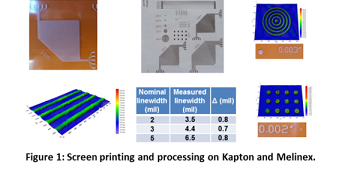
Recent Publication:
1.C Paquet, T Lacelle, B Deore, A J Kell, X Y Liu, I Korobkov, P R L Malenfant (2016) Pyridine-copper (II) formates for the generation of high conductivity copper films at low temperatures. Chem. Commun. 52: 2605-2608.
Takashi Tokumasu
Tohoku University, Japan
Title: Relation between nanoscale structures and transport phenomena in materials of polymer electrolyte fuel cell
Time : 15:45-16:05

Biography:
Takashi Tokumasu is a Professor at the Institute of Fluid Science, Tohoku University. He has his expertise in analyzing nanoscale flow phenomena. Especially, he is focusing on the effect of quantum characteristics of molecules on macroscopic flow and thermodynamic phenomena
Abstract:
Polymer electrolyte fuel cells (PEFC) are used as the next-generation power supply system due to its low environmental burden, high efficiency, and availability for dispersed power systems and emergency use. Transport resistance of reactant and product materials such as proton, oxygen and water is the determining factor of its efficiency and therefore it is necessary to analyze the transport phenomena of proton, oxygen and water in PEFC as fast as possible to develop its performance and efficiency. Computational fluid dynamics (CFD) based on macroscopic transport equations is often used as a conventional numerical analysis. A membrane electrode assembly (MEA) of PEFC, however, consists of gas diffusion layers (GDL), micro porous layers (MPL), catalyst layers (CL), and a polymer electrolyte membrane (PEM), where many nanoscale structures are constructed. In such flow fields, the characteristics of transport phenomena in MEA cannot be analyzed at the macroscopic point of view. Molecular simulation is a powerful tool to analyze these phenomena. In this study these nanoscale transport phenomena are analyzed by large scale molecular dynamics (MD) simulations and the relation between the nanoscale structures and the transport phenomena is analyzed in detail (Figure 1). Especially, the transport phenomena of proton in PEM which has highly anisotropic water structures, oxygen permeability, oxygen scattering and proton diffusivity of ionomer in CL, and the transport phenomena of nanoscale water droplet in MPL were simulated. In the analysis of proton transfer in PEM and ionomer, we considered not only Vehicle mechanism but also Grotthuss mechanism and the diffusivity of proton at various water contents were estimated. This information leads to a new design concept of materials for next generation polymer electrolyte fuel cells.
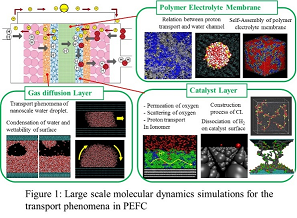
Recent Publications:
1.Kurihara Y, Mabuchi T, Tokumasu T (2017) Molecular analysis of structural effect of ionomer on oxygen permeation properties in PEFC. J. Electrochem. Soc. 164: F628-F637.
2.Mashio T, Ohma A, Tokumasu T (2016) Molecular dynamics study of ionomer adsorption at a carbon surface in catalyst ink. Electrochimica Acta 202: 14-23.
3.Fukushima A, Mima T, Kinefuchi I, Tokumasu T (2015) Molecular dynamics simulation of channel size dependence of the friction coefficient between a water droplet and a nano-channel wall. J. Phys. Chem. C119: 28396-28404.
4.Mabuchi T, Fukushima A, Tokumasu T (2015) A modified two-state empirical valence bond model for proton transport in aqueous solutions. J. Chem. Phys. 143: 014501.
Alessandra Vitale
Polytechnic University of Turin, Italy
Title: Siloxane photopolymers for PCR microfluidics
Time : 16:05-16:25

Biography:
Alessandra Vitale received her MSc degree in Material Engineering from Politecnico di Torino, Italy and in Polymers for Advanced Technologies from Université Joseph Fourier in Grenoble, France, in 2010. She obtained her PhD from Politecnico di Torino, Italy, under the supervision of Professor Roberta Bongiovanni. She has investigated innovative polymers and technologies for the fabrication of microfluidic devices. In 2014, she was engaged as Research Associate in the group of Dr. João Cabral at Imperial College London, UK. In 2016, she joined Politecnico di Torino, Italy as an Assistant Professor. Her research interests include photopolymerization processes and methods for micro- and nano-patterning.
Abstract:
Microfluidic devices represent an emerging technology with a great potential in analytical life sciences. In particular lab-on-a-chip concerning genomic applications has attracted great interest; in such systems there is often the need to provide an efficient DNA amplification by PCR (polymerase chain reaction). Nowadays, polymers are the materials of choice for the fabrication of micro devices for genomic applications. For prototyping and small-scale production, soft lithography—a family of multiple-step techniques based on molding the thermally curable elastomer polydimethylsiloxane (PDMS) is the current gold standard. However, the commercial and common thermally curable PDMS shows some drawbacks that limit its applicability in biotechnology, such as the difficulty in controlling and modifying the surface chemistry and in tuning the physical and mechanical properties of the material. An appealing alternative to thermally curable PDMS prototyping is the use of specially designed UV curable polymers, as photopolymerization is a very fast reaction that leads to the synthesis of highly cross-linked networks in few seconds at room temperature. Moreover, this technique can be applied to a wide variety of photocurable polymers, allowing to select and tune the desired physico-chemical properties of the final device. In the present work, we introduce the use of a class of photocurable siloxane polymers for the fabrication of microfluidic devices for biomedical applications (i.e., PCR). New multifunctional acrylic oligomers are synthesized (Figure 1a) and then photo cross linked. Moreover, copolymerization is used as strategy to optimize the photopolymer properties. The polymers and copolymers synthesized are suitable for bio microfluidics: they are PCR compatible (Figure 1b), highly resistant to temperature and various solvents, transparent, dimensionally stable and essentially non-permeable to water vapor. Therefore, these materials are used to fabricate microfluidic devices (Figure 1c), in which PCR is successfully conducted as proof of principle.
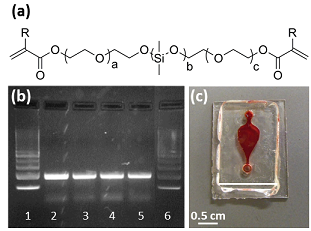
Figure 1: (a) Example of chemical structure of a synthesized acrylic siloxane oligomer. (b) Gel electrophoresis analysis of PCR-products; lanes 1 and 6: DNA ladder, lanes 2-5: addition of a polymer piece into the test tube. (c) Siloxane PCR device filled with colored water.
Recent Publications:
1. Yang J, Vitale A, Bongiovanni R, Nie J (2015) Synthesis and characterization of siloxane photopolymers used for microfluidic devices. New Journal of Chemistry 39: 2532-2540.
Adrianus M M Pruisken
University of Amsterdam, Netherlands
Title: The quantum Hall effect, the theta angle, instantons and all that
Time : 16:25-16:45

Biography:
Adrianus M M Pruisken has contributed to a variety of topics such as quantum critical phenomena, Anderson localization and interaction effects, the Coulomb blockade, the single electron transistors as well as quantum anti-ferromagnets in low dimensions. His microscopic theory of the quantum Hall effect has played a central role in motivating a stream of experimental research on the so-called “plateau-transitions”. His research interests cover the topological and non-perturbative aspects of condensed matter systems, statistical mechanics and quantum field theory.
Abstract:
The quantum Hall effect is an outstanding laboratory for investigating and exploring topological principles in quantum field theory in general, and the strong coupling problems in QCD in particular. In this talk I review some of the highlights and misconceptions spanning more than three decades of research on the subject. This includes the laboratory experiments on the quantum Hall “plateau transitions” as well as the emergence of new concepts such as “super-universality” of quantum Hall physics.
Ali Elkhalifah
Al-Neelain University, Sudan
Title: CO2 adsorption equilibria on calcium exchanged bentonite modified by mono-, di- and triethanolamines
Time : 16:45-17:05

Biography:
Ali E I Elkhalifah has expertise in clay chemistry, adsorption of gases and environmental engineering. He has worked on clay modification and development of low-cost adsorbents improving the CO2 uptake capacity on the modified clays. He has years of experience in research, teaching and administration both in academia and mission-oriented research.
Abstract:
This research work investigates the adsorption characteristics of carbon dioxide on calcium form of bentonite modified by amines at ambient conditions. For this purpose, the native exchangeable cations initially presented in the interlayer space of bentonite were replaced by calcium ions, and then the exchanged bentonite was further treated with protonated mono-, di- and tri-ethanolamines via intercalation process. The characteristics of the prepared hybrids were analyzed by XRD, BET and TGA techniques. XRD results revealed that a gradual increase in the basal spacing of bentonite with an increase in the molar mass of amines was observed. Conversely, low surface area values for bentonite were recorded by BET method. However, the thermal analysis (TGA) of the samples showed a shift to lower values in the amount of the physically adsorbed water as well as its desorption temperature. Static adsorption of CO2 on amine-bentonite adsorbents at ambient conditions showed that the molar mass of amine has an inverse effect on the gas adsorption capacity, where bentonite modified by monoethanolamine adsorbed 0.6 mmol/g compared to 0.4 and 0.3 on that one treated with di- and triethanolamines due to the pore opening effect and a consequential higher surface area.
Recent Publications:
1.Ali E I Elkhalifah (2016) Development and characterization of amine-clay hybrid adsorbents for CO2 capture. Advanced Materials Research 1133: 547-551.
2. Ali E I Elkhalifah (2015) Selective adsorption of CO2 on a re-generable amine-bentonite hybrid adsorbent. Applied Clay Science 101: 213-219.
3. Ali E I Elkhalifah (2013) Effects of exchanged ammonium cations on structure characteristics and CO2 adsorption capacities of bentonite clay. Applied Clay Science 84: 391-398.
4. Ali E I Elkhalifah (2013) Thermal properties of different transition metal forms of montmorillonite intercalated with mono-, di-, and triethanolammonium compounds. Journal of Thermal Analysis and Calorimetry 112: 929-935.
5. Ali E I Elkhalifah (2011) Thermogravimetric analysis of different molar mass ammonium cations intercalated different cationic forms of montmorillonite. Journal of Thermal Analysis and Calorimetry 110: 765-771.
Mohamad Hmadeh
American University of Beirut, Lebanon
Title: Structural features and functions of ZIF crystals made via a reaction diffusion process at room temperature
Time : 17:05-17:25

Biography:
Mohamad Hmadeh was appointed as an Assistant Professor of Chemistry at AUB in January 2014. He obtained his PhD degree in Chemistry (Jan 2010) from the University of Strasbourg (UdS) in France. His research as a graduate student was focused on molecular machines in Supramolecular Chemistry. After graduation, he joined the University of California, Los Angeles (UCLA) as a Post-doctoral fellow in the group of Professor Omar M Yaghi, who is known as one of the pioneers of Metal Organic Frameworks (MOFs). During his stay at UCLA (2010-2012), his research was focused on the design, synthesis, and characterization of novel porous and crystalline materials with exceptional gas sorption, catalysis and electronic properties. He is currently in his second year as a Post-doctoral Researcher in Professor Geoffrey Ozin’s group at the University of Toronto, where he is working on synthesis and evaluation of new photocatalysts for solar fuel production.
Abstract:
We report the synthesis of a range of zeolitic imidazolate frameworks (ZIFs) using a reaction-diffusion framework (RDF). As the imidazolate linkers diffuse into an agar gel matrix containing the divalent metal (zinc and/or cobalt), it reacts to give the corresponding ZIF. The coupling of reaction-diffusion with nucleation, growth and impingement of the growing particles leads into controlling the particle size distribution between 50 nm and 10 μm. By varying the temperature, the concentration of the reagents, and the thickness of the gel matrix, control of the size and morphology of the ZIF crystals is achieved. Also, we show that by using the RDF, we are able to visualize the formation mechanism of ZIF crystals. This novel method for synthesizing ZIFs is rapid, scalable, and environmentally friendly. Furthermore, the effect of cobalt-doping on the photocatalytic properties of ZIF crystals is explored by examining the extent of methylene blue (MB) degradation by each ZIF under visible- light irradiation.
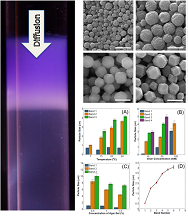
Figure 1: Synthesis of ZIFs via reaction diffusion framework.
Recent Publications:
1.M Al-Ghoul, R Issa, M Hmadeh (2017) Synthesis and structural evolution of metal-organic framework-199 via reaction diffusion process at room temperature. CrystEngComm 19: 608-612.
2.Z Moussa, M Hmadeh, M G Abiad, O H Dib, D Patra (2016) Encapsulation of curcumin in cyclodextrin-metal organic frameworks: Dissociation of loaded CD-MOFs enhances stability of curcumin. Food Chemistry 212: 485-494.
3.D Saliba, A Ezzeddine, R Sougrat, N M Khashab, M Hmadeh, Mazen Al-Ghoul (2016) Synthesis of CdAl layered double hydroxide hierarchical microspheres via a reaction-diffusion framework and their photocatalytic activity for CO2 reduction. ChemSusChem 9: 800-805.
4.A A Jelle, M Hmadeh, P G O’Brien, D D Perovic, G A Ozin (2016) Photocatalytic properties of all four polymorphs of nanostructured iron oxyhydroxides. ChemNanoMater 2: 1047-1054.
Nazim Babacan
Gazi University, Turkey
Title: Influence of grain size on super elasticity and actuation properties of Cu-Al-Mn shape memory alloys
Time : 17:25-17:40

Biography:
Nazim Babacanis is pursuing his PhD studies in the Department of Mechanical Engineering under the supervision of Dr. Benat Kockar and Dr. Selim Turkbas. The topic of his PhD thesis is “Enhancing mechanical properties of Cu-Al-Mn shape memory alloys”. He was a Visiting Scholar at Texas A&M University under the supervision of Dr. Ibrahim Karaman. His studies focused on the actuation properties and thermo-mechanical stability behaviors of Cu-Al-Mn shape memory alloys within the scope of the thesis and found important results that clarify the relationship between microstructure and macro-behavior of these alloys.
Abstract:
Grain size is one of the main microstructural parameters which dictate the shape memory properties of Cu-based shape memory alloys (SMAs). In this study, grain size control of Cu73Al16Mn11 (%) shape memory alloy was achieved via cold rolling–short time post annealing technique. While homogenized material has an average grain size of 900 µm, 260 µm average grain size was obtained after 70% rolling at room temperature and subsequent 950ºC 80 seconds heat treatment. Super elasticity and actuation properties of homogenized and thermo-mechanically treated material were compared by utilizing incremental cyclic tensile and isobaric heating-cooling experiments respectively. It was found that decreasing the grain size had no effect on the superelastic properties of the material, however, residual strains obtained from isobaric heating-cooling experiments decreased prominently. These two contradictory results can be explained by two mechanisms. Since stress level in super elasticity tests are higher (about 300 MPa when transformation starts) than that of in the case isobaric heating-cooling tests (maximum 140 MPa tension stress was applied), stress concentrations at the grain boundaries lead to intergranular fracture owing to high elastic anisotropy of the Cu-based SMAs. On the other hand, strengthening effect of grain size reduction is the main mechanism to increase the dimensional stability by impeding the motion of dislocations that occurs due to the martensitic transformation in isobaric heating-cooling experiments.

Figure 1: Recovered transformation strain and residual strain as a function of applied stress for materials that have different grain size
- Session 1: Nanomaterials | Mechanics, Characterization Techniques and Equipments
Location: Olimpica 1
Chair
Kyuman Cho
Sogang University, South Korea
Co-Chair
Olga Barrera
University of Oxford, UK
Session Introduction
Li Wang
Beijing University of Technology, China
Title: Photoelectron spectra of GexSb20Se80-x Glasses
Time : 10:15-10:35

Biography:
Wang Li is a Professor at the Beijing University of Technology, China. She has her expertise in novel laser with all solid state and nonlinear optics, nanomaterials and technology in improving the optical materials and laser. She has published 130 papers in international journals and conferences of these areas. She is now a member of the SPIE, OSA and the Optical Society of China.
Abstract:
Several GexSb20Se80-x glasses are prepared (x=5, 10, 15, 17.5, 20 and 25 mol%), and measured their Raman and X-ray photoelectron spectra (Ge 3d, Sb 4d and Se 3d) in order to understand the evolution of the glass structure as a function of chemical composition. We further decomposed the spectra into different structural units following the assignments of these structural units in the previous literature. It was found that, Se-Se-Se trimers structural units exists in the Se-rich glasses, but the number of the trimers structural units decreases rapidly with increasing Ge concentration and finally becomes zero in Ge15Sb20Se65 glass. With increasing Ge concentration, the amount of GeSe4/2 tetrahedral structure increases and that of SbSe3/2 pyramidal structure remains almost no changes in the Se-rich glasses. On the other hand, the number of Ge-Ge and Sb-Sb homopolar bonds increases with increasing Ge concentration, and that of the GeSe4/2 tetrahedral and SbSe3/2 pyramidal structures decrease in the Se-poor glasses. Moreover, the Se-Se homopolar bonds exist in all the glasses, and they cannot be completely suppressed. When the composition is close to chemical stoichiometry, the glass is dominated by heteropolar Ge-Se and Sb-Se bonds with negligible amount of Ge-Ge, Sb-Sb and Se-Se homopolar bonds. The transition threshold occurred at the chemically stoichiometric glasses rather than the transition predicted by the topological constraint model suggested that, chemical order rather than topological order is a main factor in determining structure and physical properties of Ge-Sb-Se glasses.
Kazuki Nagashima
IMCE Kyushu University, Japan
Title: Nanocellulose based flexible, environment-friendly nonvolatile resistive switching memory
Time : 10:35-10:55

Biography:
Kazuki Nagashimahas done his PhD and currently is an Assistant Professor in Institute for Materials Chemistry and Engineering, Kyushu University. He received his BSc and MSc in Material Science from Osaka University, and PhD from Osaka University in 2010. He also received the NF Foundation R&D Encouragement Award, Inoue Research Award for Young Scientists in 2013, MNC Young Author’s Award, Sasakawa Young Researcher Award and Funai Foundation Young Researcher Award in 2012. Currently, he focuses on the nanoscale electrical and thermal transport phenomena into one-dimensional metal oxide nanowires and their applications.
Abstract:
Recent rapid development in flexible electronics gives us opportunities for low cost wearable IoT applications, which offers the real time monitoring of individuals’ health status in daily life by taking the information from human body and transferring them from device to device through internet. Although the data should be continuously transferred between devices for realizing real time monitoring, they cannot be obtained if the target human stays under the non-internet environment. In this regard, light-weight, flexible, single-use and disposable nonvolatile memory devices are strongly desired for wearable IoT technology to store the data temporarily even when the target stays under non-internet environment, and to waste them when they finish the role. However, conventional memory devices are not flexible enough and not disposable since they are mostly made of non-renewable, non-biodegradable semiconductor materials and some toxic materials, causing a serious damage for ecological system when they are emitted to environment. Here we demonstrate nanocellulose based flexible and disposable nonvolatile memory. Nanocellulose is renewable and the most abundant biomass on earth, and has outstanding properties including high tensile strength and low thermal expansion coefficient. We first successfully realized the ultra-flexible resistive nonvolatile memory using Ag-decorated nanocellulose paper. The Ag-decorated nanocellulose paper showed the stable nonvolatile memory effects with 6 orders of ON/OFF resistance ratio. The memory performance of nanocellulose paper can be maintained without degradation when being bent down to the radius of 350 mm, which is the smallest value compared to those of existing flexible nonvolatile memories. Second we constructed an environment-friendly, disposable nonvolatile memory device composed of 99.3 vol.% nanocellulose. The device exhibited the biodegradability, which was confirmed by burying it into the natural soil for 26 days. Thus the present device using abundant and mechanically flexible nanocellulose paper offers a highly flexible nonvolatile memory for wearable IoT applications.
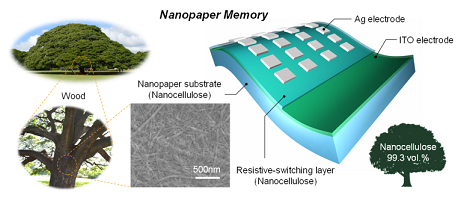
Anna Baldycheva
University of Exeter, UK
Title: 2D material fluid nanocomposites for reconfigurable integrated optoelectronics and Si photonics
Time : 11:20-11:40

Biography:
Anna Baldycheva has completed her BSc from Saint-Petersburg University in 2008 and PhD from the Trinity College Dublin in 2012. She is an Assistant Professor in 2D Optoelectronic Materials at the University of Exeter since 2014, where she is currently leading a highly interdisciplinary research group i.e. Optoelectronic Systems Laboratory. She has extensive expertise in the design, fabrication and testing of integrated Si micro-photonic systems. Since 2011, she has over 50 peer-reviewed publications, invited talks and conference proceedings. She is an Associate Editor of the Nature Scientific Reports and is serving on Board of the Royal Microscopy Society Engineering Section.
Abstract:
Today, innovation of novel reconfigurable materials, which can be integrated on chip with CMOS compatible process and used for engineering devices, is the key driver for realization of future chip-scale multi-functional systems. Among recently emerged optoelectronic materials the fluid-dispersed atomically thin two-dimensional (2D) nanocomposite materials have sparked a great level of interest for their high promise as in-situ tailored meta-material device platform for the next generation of multi-functional (opto)-electronic systems with a wide range of important applications, such as renewable energy, optical communications, bio-chemical sensing, and security and defense technologies. Dynamically controlled three-dimensional self-assembly of suspended 2D liquid exfoliated nano-flakes not only provides a breakthrough route for technological realization of 2D material based 3D device architectures, but also its fluidic nature allows CMOS-compatible back-end integration on chip using microfluidic technology. This opens up almost limitless possibilities in the fabrication of compact and low-power systems for the realization of commercially viable, miniaturized, multi-functional light-management devices, for example light sources, tuneable optical filters and nano-antenna phased arrays. We will demonstrate the possibility to low-power controllable manipulation of 2D nano objects directly on chip utilizing fundamental tuning approaches in Si photonics: electro-optic and thermo-optic effects, as well as discuss the first practicable 2D fluid composite based device designs for application in integrated photonics. We will further focus on the dynamics of 2D nano platelets spatial alignment, understanding of which is essential for the first practicable realization of three-dimensional met structure formation on-chip. Through the optimization of the SOI (silicon-on-insulator) based optofluidic system design to enable simultaneous in-situ Raman spectroscopy monitoring of 2D dispersed flakes during the device operation we have successfully demonstrated possibility for the first time a label-free 2D flake detection via selective enhancement of the Stokes Raman signal at given wavelengths. This approach has then been applied to monitor the individual 2D nano platelets in dynamics within a microfluidic channel on chip during application of external stimuli. We discovered ultra-high signal sensitivity to the xyz alignment of 2D flakes within the opto-fluidic channel, which in turn enables precise in-situ alignment detection for the first practicable realization of 3D photonic microstructure shaping based on 2D-fluid composites and CMOS photonics platform.
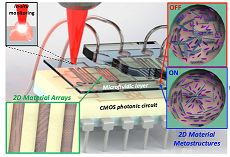
Penny Govender
University of Johannesburg, South Africa
Title: Supporting titanium on silica, graphene, epoxy graphene and carbon nanotubes: A first-principles study
Time : 11:40-12:00

Biography:
Penny P Govender is a Senior Lecturer in the Department of Applied Chemistry, University of Johannesburg. She received her PhD in 2013 from the University of the Witwatersrand, South Africa. She has extensive experience in academia and is currently the Molecular Modelling Group Leader and Head of Department of Applied Chemistry. Her research areas include bioinorganic, computational chemistry, numerical modeling, quantum chemistry and material science. She has published papers in high-impact journals and has presented her work on both national and international platforms.
Abstract:
The use of silica has been studied as a support material with other materials. Since the establishment of ballistic transport and electrical properties of graphene, several researches have been conducted on the interaction between graphene and silica. However, incorporation of TiO2 on graphene-silica resulted in a memristor based on the titanium oxide films and titanium nitride electrode. Enhance textual properties of multi-walled carbon nanotubes (CNTs) with a high loading when TiO2 is supported on multi-walled carbon nanotubes and SBA-15 is revealed. To understand the origin of the electron transfer during photocatalysis, a projected density of state is conducted to assess the orbital contribution in the charge transfer and the effect of introducing TiO2.All the calculations are performed using density functional theory, with the generalized gradient approximation parameterization of Perdew-Burke-Ernzerhof functional as implemented in Cambridge Serial Total Energy Package of Material Studio 2016. To simulate the interfacial and optical properties of the composite material, the powder diffraction patterns and Raman spectra for the starting structural models, as well as pure TiO2, graphene and epoxy graphene monoxide are computed. The electronic and optical properties analysis of the epoxy-graphene monoxide and graphene composites are found to be more sensitive in the visible region (400 to 800 nm) compared to the TiO2, SiO2, and graphene and epoxy graphene monoxide monolayers. The electrostatic potential of the composites is reduced compared to the individual monolayers, which indicates effective electron transfer. Therefore, the new composite material is superior in properties and would find applications in TiO2-based photocatalyst material by exploiting the advantages of other materials.
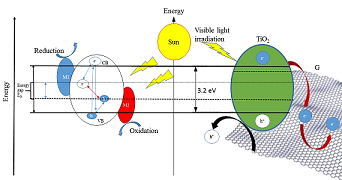
Maria Richetta
University of Rome “Tor Vergataâ€, Italy
Title: Nanostructure Layered Double Hydroxides (LDH): synthesis, characterization and possible applications
Time : 12:00-12:20

Biography:
Maria Richetta has a specific expertise in laser and laser applications for the treatment and preparation of materials. Particular attention has been paid to the study of nanostructured materials. During the last years she has been involved in the characterization of different materials, in particular innovative metallic alloys, through other technique such as XPS, AES, SEM, TEM, XRD and Mechanical Spectroscopy.
Abstract:
Layered double hydroxides (LDHs) are ionic lamellar materials belonging to the group of anionic clays. The structure of LDHs is based on brucite-like layers containing a divalent M2+ cation coordinated with six OH- hydroxyl groups. The substitution of the M2+ metal, with a trivalent M3+ cation, gives rise to the infinite repetition of positively charged sheets (lamellas) alternating with An-ions. The layered structure has attracted increasing interest, because it can host complex organic molecules, intercalated in the interlamellar space. Engineered LDHS can find a wide variety of applications. For instance, they have been investigated as additives in anticorrosion coatings, in flame-retardants, for water treatment and purification, or for biomedical applications like drug delivery and biosensors. Several techniques can prepare LDHs crystallites as: simple one-step hydrothermal process at room temperature;co-precipitation; ion exchange; memory effect reconstruction. To characterize those materials various methods can be applied: from X-ray diffraction to X-ray Photoemission Spectroscopy and Auger Electron Spectroscopy. In the present work we will describe the LDHs samples, obtained in our laboratories, varying the growth parameters, with different substrates and on different layers. We will describe the growth of the structure either on biosensors or on circuit, and the intercalation into the nanostructure of biological molecules. The possible correlated applications as gas sensors, drug delivery systems, nanostructured-modified textile, etc. were also been shown

Annivar Ryan
DOST-FPRDI, Philiphines
Title: Nanocrystalline cellulose from abaca fibers
Time : 12:20-12:40

Biography:
Anniver Ryan P Lapuz is a Materials Science and Chemical Engineer. His topic of interest is to explore the potential of nanocellulose from locally abundant agro-lignocellulosic materials. His researches on green composites such as fiber reinforced thermoplastic starch as substitute for single use packaging would further be enhanced using nanotechnology to improve its mechanical and physical properties. His current studies include reinforced thermoplastic starch (TPS) used for thin film and expanded TPS applications.
Abstract:
Nanocellulose is an emerging nanomaterial that is sustainable, renewable, biodegradable and biocompatible. This material can be used for health and green composites applications such as reinforcement materials for high performance nanocomposites, pharmaceutical, chemical and food additives, optically reflective films, high durability varnishes and innovative bio-plastics. Abaca or Manila hemp is one of the most abundant endemic lignocellulosic agro-based fibres in the Philippines which can be an excellent source of nanocellulose. At present, its applications are still limited to cordages, textile, and handicrafts. This study aims to determine the characteristics of nanocrystalline cellulose (NCC) extracted from a disease resistant hybrid variety of abaca fibre that can be used as reinforcement fillers in composite applications. Hybrid abaca fibers were soda pulped and subsequently bleached using HEHEH sequence. Chemical properties of bleached hybrid abaca pulp were comparable with commercial abaca varieties. Different hydrolysis conditions were used to extract NCC from bleached abaca pulp. Acid hydrolysis at 64% sulfuric acid concentration showed that almost all the cellulose has been degraded as observed from the low yield in solid suspension and a brown to dark brown coloration at different reaction time. In contrast, a white cloudy suspension was observed at lower acid concentrations. Chemical and physical processes were conducted to isolate the nanocrystalline cellulose of different acid concentrations acid resulting in a hazy white solution. Among the various acid concentrations, a particle size distribution profile of 23.38 nm using dynamic light scattering technique (Figure 1) was observed from the hydrolysis of abaca pulp at 55% acid concentration reacted for 60 minutes. In addition, a 15% NCC yield with a 0.4% NCC concentration was obtained from the hydrolysis of abaca pulp.
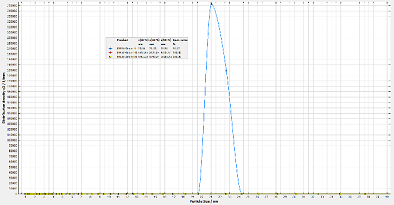
Kyuman Cho
Sogang University, South Korea
Title: A high resolution, multi-purpose scanning I/Q-interferometer scheme for material diagnostics
Time : 12:40-13:00

Biography:
Kyuman Cho has expertise in precision measurements using various interferometer schemes. He has been performing extensive researches in developing interferometric approaches in many high sensitivity applications sensors such as a scanning microscopy for characterization of optical properties of surfaces and materials, readout sensor for reaction monitoring on a biochip, long range vibrometer, and many other applications. He has been also working on diagnostics of the magnetically confined plasma in KSTAR, the fusion reactor project in South Korea. He is a Professor of Physics at Sogang University since 1992. He has been a Visiting Professor in the Department of Electrical and Computer Engineering, University of Maryland, USA and at the Institute of Cosmic Ray and Radiation, University of Tokyo, Japan. He is a Collaborator for KAGRA, a cryogenic gravitational wave antenna, being built in Kamioka, Japan
Abstract:
An I/Q-interferometer (IQI) scheme is ideal for both macro and micro-resolution diagnostics of various materials and devices, because it can measure the amplitude and phase change induced on the probe beam (PB) by the linear or nonlinear interaction with the sample under test. We recently proposed the new IQI scheme in which the PB and the reference beam (RB) in the interferometer are geometrically balanced as shown in the image. This arrangement is particularly advantageous in the application of the scanning microscopy because the IQI is not susceptible to any noise caused by lateral and transverse motions of the stage during the scanning. Various applications of the scanning IQI on the material diagnostics have been studied. The interferometer can provide the map of the local variations of the complex reflectance of the surface if the sample is reflective while the map of the local variations of the complex refractive indices can be obtained if the sample is transparent. In the latter case, the sample is mounted on a mirror which reflects the PB back into the interferometer. In the case of reflection measurements, images representing variations of the local topography and material inhomogeneity of the surface under test can be obtained by mapping point-to-point changes of the phase and amplitude values of the PB during the scanning. In the case of transmission measurements, the analysis may be more complicated, but, in principle, the amplitude and phase of the PB are determined by the absorption coefficient and optical thickness of the sample under test. In this presentation, details about the scanning IQI and its applications will be discussed.
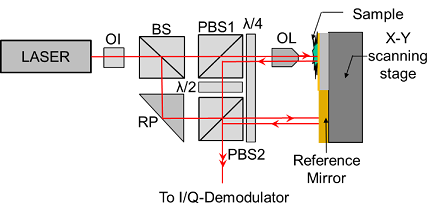
Olga Barrera
University of Oxford, UK
Title: Coupling diffusion and mechanics modeling for hydrogen embrittlement (HE)
Time : 13:00-13:20

Biography:
Olga Barrera is a Senior Researcher Associate at the University of Oxford. Her expertise is in the field of computational mechanics and computational material modeling. Her research focuses on solving a range of coupled diffusion mechanics problems focused on understanding the failure process of a number of material systems. She also has experience in applying the wide range of skills developed in the fields of materials modeling and computational solid mechanics to solve exciting and important problems in parallel disciplines such as biomechanics.
Abstract:
This work deals with modeling HE mechanisms in high strength steels. The aim is to elucidate two failure mechanisms in the presence of hydrogen: Hydrogen induced local plasticity (HELP) and hydrogen induced decohesion (HID). The HELP theory suggests that hydrogen, in contrast to the usual understanding of embrittlement, enhances the dislocation mobility and promotes slip localization, resulting in localized plastic failure. Furthermore, hydrogen reduces the bonding energy between atoms leading to decohesion. The HID mechanism might explain the brittle intergranular fracture surface observed in high strength steels. Experimental evidence of the occurrence of HELP versus HID or, more probably, their synergetic effect, is still an unresolved issue. Hydrogen atoms can accumulate, either within the matrix or at interfaces (i.e., between particles and the surrounding matrix, or grain boundaries) affecting the mechanical response of the material. We construct a finite element model in order to simulate the mechanical behavior of the matrix and interface coupled with hydrogen transport. We also include simple kinetic models of the flux of atoms into (and out of) an interface. We combine this understanding with micromechanical models of the interaction of dislocations with particles and with empirical models of the effect of hydrogen on interface decohesion and plastic deformation to provide a set of coupled constitutive equations for hydrogen transport and mechanical behavior. With this modeling framework, we aim to identify and explore the conditions under which HELP or HID or both mechanisms are activated. In particular, we model the failure of high strength steels which contain a distribution of nano-scale particles. We simulate the response in hydrogen and hydrogen-free environments and identify the conditions under which hydrogen can lead to: (a) a quasi-brittle macroscopic response through localization of plastic deformation facilitated by decohesion at the particle/matrix interface or (b) a brittle intergranular fracture process.
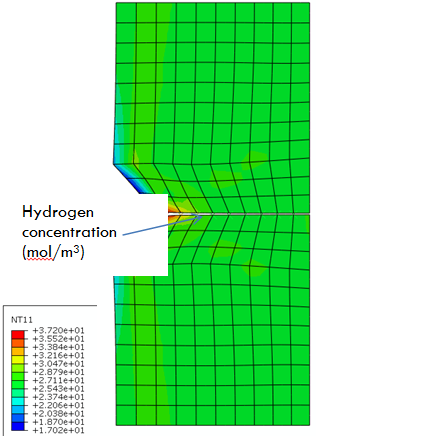
Jérôme Colin
University of Poitiers, France
Title: Effects of plasticity and pressure on the morphology and propagation of blisters: formation of croissant and donut-like buckles
Time : 14:00-14:20

Biography:
Jérôme Colin works in the field of the Mechanics of Materials and Materials Science. He is involved in the modeling of the mechanical properties of nano-structured materials, thin films on substrates and coatings. More precisely, he has constructed models in the framework of the elasticity and thermodynamics theories, to characterize the morphological evolution of layers under strain, the formation of atomic defects such as dislocations in strained nanostructures or the delamination and buckling of thin films on substrates.
Abstract:
In a first part, the formation of donut and croissant-like buckles that have been observed onto the free-surface of strained gold thin films deposited on silicon substrates (see figure 1) has been studied from a static point of view by means of finite element simulations. Taking into account the combined effects of the atmospheric pressure applying onto the upper free-surface of the films and of the plastic folding at the circumference of the blisters, the different morphologies of the buckles have been explained. A “shape” diagram for the buckles has been provided as a function of the pressure and of the internal compression strain. The shape and width of the blisters numerically obtained and experimentally observed have been finally analyzed and have been found to match (see figure 2). In the second part, the propagation of the buckles appearing onto the surface of the gold thin films on silicon substrates has been investigated from a dynamical point of view, in the case where atomic steps are present at the film-substrate interface. Although it has only been experimentally observed that the buckles always propagate along the steps on the surface of gold films, the conditions on the internal compression strain in the films, the orientation of the steps with respect to the buckles and the step heights have been determined for the step crossing or step following phenomena. A “propagation” diagram is finally provided versus the angle a between the steps and the compression strain and the step height H
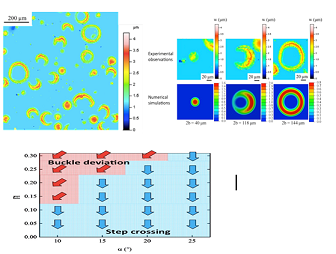
Christine Frayret
Université de Picardie Jules Verne, France
Title: Rational design of organic electrode materials: New advances and tools
Time : 14:20-14:40

Biography:
Christine Frayret is an Associate Professor and has done her PhD degree from the University of Bordeaux 1, Institute of the Chemistry of Condensed Matter from Bordeaux (ICMCB, CNRS UPR 9048) France. She was mainly involved in the area of solid electrolytes/electrodes for fuel cells and luminescence of materials. She then joined the Laboratory of Reactivity and Chemistry of Solids at University of Picardie Jules Verne (LRCS, CNRS UMR 7314, Amiens, France), where she started to focus on battery materials. Her most recent work addresses determination of structure-property relationships, identification of guidelines for the design of energy related materials, especially for the potential next generation storage devices involving novel more eco-friendly organic electrodes and investigations on photochromic materials.
Abstract:
The demand for sustainable energy sources has stimulated great interest in new technologies and materials. A multitude of research efforts in recent years have led to marked progress in this area, including in particular lithium-ion batteries based on organic electrodes. A significant milestone in designing such materials would correspond to the comprehension of the rules governing the increase/decrease of the redox potential of molecular entities, especially if differentiation between various backbones/functional groups/redox centers or incidence of atom substitution within rings can be reached. Based on the combined use of molecular quantum simulation and accurate examination of the electronic structure properties, a rational design of organic electrode materials can be performed. In addition to spin density populations’ estimation, different additional tools can be used to understand molecular redox potential trends. For instance, NICS (nuclear independent chemical shift), HOMA (harmonic oscillator model of aromaticity), d FLU indicators, etc., have the opportunity to electron delocalization on various rings/bond paths within a molecule in a quantitative way. In this context, the partitioning of the global energy of the molecule may constitute another analysis instrument to shed light on the various pieces of molecule playing the main role in stabilization/destabilization upon reduction or how balance between some competitive effects does occur. Such approach can be applied to systematic theoretical screening of existing compounds/hypothetical novel candidates, both being tuned through various effects. This should progressively complete the database for the discovery of new/optimized organic electrodes with improved features. Thanks to this methodology a work of prospection has been undertaken on various families, including derivatives of quinone, carboxylate, quinoneazine and pentalenedione. By focusing on these various sets of compounds, we identified some property-based guidelines, which may serve not only for the ranking of the studied entities but also for the search of more advanced systems.
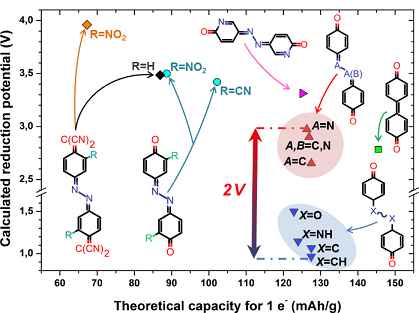
Natalie German
Technical University of Munich, Germany
Title: Computational investigation of the kneading process of bread dough
Time : 14:40-15:00

Biography:
N Germann research group focuses on the rheology, i.e., the flow behavior, of viscoelastic fluids that are of industrial relevance. The reason for the unusual rheological properties of viscoelastic fluids is their microstructural dynamics. To establish a more fundamental understanding of viscoelastic fluids, her research group investigates the relationship between their rheology and their microstructure. The research approach combines thermodynamic modeling and numerical simulation with laboratory experiments.
Abstract:
A key step in the production of bread is the kneading process. The aim of this process is to form the gluten network and to bring air into the dough. While too little kneading results in dough with limited gas storage capacity, too much kneading can destroy the gluten network, impairing the dough’s ability to rise. There is a connection between the rheological properties of kneaded dough and the final quality of bread. Since scientific basis is lacking, the industrial kneading process is currently controlled using visual and haptic information from experienced personnel. Therefore, the goal of this project is to investigate the kneading process using CFD. For the rheological description of the dough, we used a new model developed by Tanner et al. (2011). We determined the exact values of the model parameters by fitting the model to small amplitude oscillatory shear, stress relaxation, transient simple shear, and uniaxial compression data. In the dough model, a so-called damage function is used to describe the partial degradation of the starch and the proteins during the deformation. We have slightly modified this function to prevent a drastic decrease in the moderate deformation range. With the help of this modification, we obtained an excellent agreement with the experimental data (see Fig. 1). Due to its complexity, the dough model has not yet been solved for an inhomogeneous flow field. In this talk, we will present the first results of such a simulation, performed in the annular gap between two eccentric cylinders. This benchmark geometry is an idealized form of a kneader. We will discuss the numerical solution strategy that we have implemented in OpenFOAM. A further focus will be the relative influence of the rotational speed on the shear and extensional deformations.
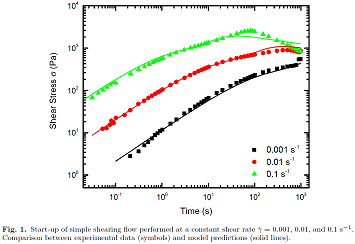
Aitor Larrañaga Varga
University of the Basque Country, Spain
Title: Materials characterization by X-ray diffraction techniques
Time : 15:00-15:20

Biography:
PhD from the University of the Basque Country in 2005 in Materials Science concerning Transition Metal Selenites. Researcher in Materials Crystallography 01/04/2005-03/07/2007, Advanced Technician, General Research Services 03/07/2007- present. Specialization in material characterization techniques and results analysis. X-ray diffraction; not environment measurements, size-strain, quantification, full profile analysis, texture, stress, orientation, grazing incident, micro-diffraction. Material and components, structure optimization. Synthesis and study of new materials with technological applications. Structure-property relationships. More than 50 international Publications (ISI Web of Knowledge), 3 books chapters, more than 90 conference Communications. Participation in national (7), Basque Government (8) and University (2) research projects. Supervision of PhD thesis (2015), next lecture PhD thesis 2018. More than 10 given courses focused on X-Ray Diffraction, participation in Master and Doctoral School since 2007/08. Assistance to more than 60 courses or training sessions related with materials research and teaching.
Abstract:
Integrated in the General Research Services of the University of the Basque Country, UPV/EHU, the X-ray Unit, provides the possibility to study single crystals, polycrystalline samples or amorphous materials, under a wide range of conditions. The available equipment enables structural studies starting from diffraction data of polycrystalline materials. This technique allows us to identify the crystalline phases presented in the samples, crystal size estimation, size/strain analysis, particle morphology or structural mean parameters study. The full profile simulation could give us all the structural information, perhaps compositional results and quantitative analysis of materials. In the other hand different equipments and configuration implemented in the service give us the possibility to; make high and low temperature measurements, layer thickness calculations, obtain deepness gradient information, texture analysis, stress measurements, crystal orientation, micro-diffraction, etc. The X-Ray Service supports basic and applied research through scientific and technical advice and the use of a high-performance infrastructure in materials analysis with applications in many areas of knowledge.
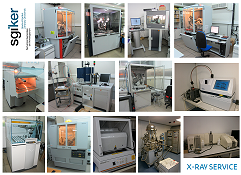
Ebru Saraloglu Güler
Baskent University, Turkey
Title: Internal stress and friction measurements during MoS2-nickel electrodeposition
Time : 15:20-15:40

Biography:
Ebru Saraloglu Güler is an Assistant Professor in the Department of Mechanical Engineering at the Baskent University in Ankara, Turkey. She received her BSc and MSc degrees from the Middle East Technical University, Turkey in 2006 and 2008, respectively. She got her PhD degree from Metallurgical and Materials Engineering Department of Middle East Technical University in 2013. Her main interests are phase electroplating and composite materials.
Abstract:
The electroplating method is a promising alternative to produce composite plating by using dispersed fine particles in the metal plating bath. The process can be either called electro co-deposition or composite deposition. The particles are trapped in the deposit during the process. Internal stress is a common problem in plated deposits that affect the performance of the coatings and may even result in adhesion problems. Hence, the amount and type (compressive or tensile) of the internal stress must be controlled. MoS2 particle-nickel coatings can be referred as self-lubricating coatings that satisfy the demand for decreased friction in severe applications. The internal stress during MoS2 particle-nickel electrodeposition was measured by deposit stress analyzer. The effects of electroplating parameters that are MoS2 particle concentration (0 and 10 g/l), temperature and coating thickness (25 and 50 µm) on the internal stress values were investigated by Taguchi design. It is found that increasing MoS2 particle concentration and coating thickness led to decrease in the internal stress developed during MoS2-nickel composite coatings. Interaction effects of these parameters were also revealed. The most effective parameter on internal stress was determined as MoS2 concentration by regression analysis. Therefore, three different MoS2 concentrations (0, 10 and 30 g/l) were studied in order to find out the concentration effect on the coefficient of friction and wear rate by pin-on-disc tribometer.

Juhwan Lim
Agency for Defense Development, South Korea
Title: In-situ measurement for ablation geometry during impinging of plume with laser triangulation method
Time : 15:40-16:00

Biography:
Juhwan Lim has his expertise in carbon material, from nano-sized graphene to macro size carbon/carbon composite. He did his BS (2011) and MS (2013) in the Department of Mechanical Engineering from Yonsei University, Seoul, South Korea. His major field of study is synthesis, device fabrication, and optoelectrical property characterization of graphene, graphene oxide and relating nano-composites. Currently, he is a Researcher at the Agency for Defense Development. He has published 16 papers in international journal, including Journal of Physical Chemistry-C, Carbon, Journal of Materials Chemistry and Scientific Reports. Currently, his research also focuses on designing, testing and characterization of anti-ablation and thermal protection composite materials such as C/C, G/P and other FRP composites for applying it to advanced thermal protection system.
Abstract:
In-situ ablation measurement of glass phenolic (G/P) composite during hot plume impinging was studied using laser triangular method. G/P, a representative anti-ablative material has been studied for its application in aerospace, automobile, and defense area. Especially, the ablation mechanism by aerodynamic heating has been well studied with various measurement methods for developing accurate computational model. However, when G/P is required to resist impinging plume, such as plume resistance plate in vertical launching system, different ablation behavior exhibits which demands another investigations for this mechanism and computational model. Therefore, in-situ measurement method for proving mechanism and developing computation model of ablation with impinging plume of high pressure and temperature is highly required. The G/P composite, a suitable material for resisting impinging plume from rocket nozzle, was tested its ablative characteristic using small-scaled booster with 16% concentration of alumina particle. The plume impinged vertically to material surface with about two seconds. During the test, real-time measurement of ablation geometry was conducted with laser triangular method, using laser wavelength of 405 nm and laser intensity of 0.44 W. The laser spots were spread on material surface by diffractive optical elements, and monitored using high-speed camera. The laser signal was distinguishable even in the atmosphere of existing hot plume by installing optical filter, and the movement of laser spots during the test was monitored and calculated to ablation rate. The transient section of combustion and radiation of hot plume occasionally shaded the laser, while the highest precision level of real-time recession measurement confirmed. Moreover, the high accuracy of this method has been proved via comparing with thermocouple signal and geometry scanning after the test. We believe this method, which firstly conducted with highest accuracy and stability, showed its high potential for broaden research of anti-ablative materials.
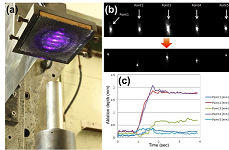
Zahoor Ahmad
Kuwait University, Kuwait
Title: Chemically bonded aramid-MWCNTs nano-composites: Morphology and thermal-mechanical properties
Time : 16:25-16:45

Biography:
Z Ahmad is working on Polymeric Nano-Composite Materials. He is a Professor in Kuwait University. He did his PhD from Manchester University, UK in1978 and Post-doctoral work from the Institute of Mechanical Process Engineering and Mechanics, Germany. He was a Senior Fellow in the Polymer Research Center, University of Cincinnati, USA and has worked as a Visiting Professor in the Saarland University and in the Max Planck Institute for Polymer Research, Germany.
Abstract:
Aramid-multiwalled carbon nanotubes (Ar-MWCNT) nano-composites using functionalized and pristine CNTs with different loadings have been prepared. High molecular weight amine terminated aramid chains were prepared by the reaction of mixture of meta- and para-phenylene diamines with terephthaloyl chloride in the solvent dimethylacetamide. These chains were linked chemically with the acid-functionalized MWCNTs. Thin composites films with different MWCNT loadings were prepared by the solvent elution technique. The effect of interfacial interaction on the composite morphology was investigated by scanning electron microscope (SEM). Dynamic thermal mechanical analysis (DMTA) showed a higher increase in the storage modulus and the temperature involving α-relaxations on CNTs loading in comparison to the system where pristine CNTs were used. The depression in the tan delta peak indicates the polymer material in composite material participating in the glass transition was reduced on loading with the MWCNT. The maximum tensile strengths with 7.5 wt% of CNTs were 166.8 MPa. Thermal mechanical analysis showed a drop in coefficient of thermal expansion, prior to glass transition temperature and was reduced to 39.8 ppm/ºC that is consistent with immobilization of polymer material present at the CNT interface. The thermal decomposition temperature of these composites was around 533ºC. Strong interfacial interactions of the matrix with the functionalized CNTs in the composite materials resulted in higher viscoelastic properties and a reduction in the coefficient of thermal expansion of aramid on loading the MWCNTs.
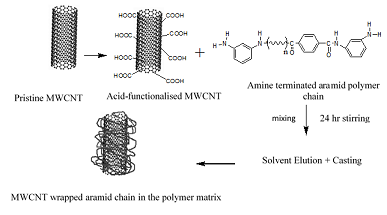
Sandile Simelane
University of Johannesburg, South Africa
Title: The fate, behavior and effect of WO3 nanoparticles on the functionality of an aerobic treatment unit
Time : 16:45-17:00

Biography:
Sandile Simelane obtained his BSc degree from the University of Swaziland (UNISWA), where he majored in chemistry and biological science. Apart from his degree, he also holds certificates in Human resource management, entrepreneurship, and introductory to wastewater treatment. He was then employed by Coca-Cola Swaziland as a Laboratory Chemists for a period of seventeen months. His main role included method validation, equipment troubleshooting and preventatives maintenance and analysis of incoming materials. Whilst employed by Coca-Cola, He was also trained in ISO 17025 by SANAS. Being a person of excellence, and willing to expand his scientific knowledge, Mr. Sandile decided to pursue a higher degree in chemistry. He is currently an MSc Chemistry student at the university of Johannesburg, where his research interest is on understanding the fate and behaviour of engineered nanomaterials
Abstract:
As a promising organic photocatalyst in wastewater treatment, understanding the fate and behavior of the WO3 nanoparticles and its impact on the functionality on the treatment plant is of paramount importance for accurate toxicological risk assessment. This was achieved through acclimatization of activated sludge to the simulated wastewater treatment plant operated according to the Organization for Economic Co-operation and Development 303A guidelines. During acclimatization, chemical oxygen demand (COD), and a five-day biological oxygen demand (BOD5) were monitored. Humic acid impact on the functionality of the domestic waste water treatment plant was investigated as it is a major constituent of wastewaters. The COD removal was above 80% suggesting that humic acid had no impact on the activated sludge activity. The fate of m-WO3 was monitored using X-ray diffraction and scanning electron microscope coupled with electron dispersive x-ray. X-ray diffraction analysis showed presence of m-WO3 in the sludge which was further confirmed with electron dispersive x-ray -mapping which showed presence of tungsten signifying adsorption of the nanoparticles on the sludge. Up-to the addition of 15 ppm WO3 showed to have an effect on functionality of the treatment plant as the COD removal dropped to 70 % which is below the 80% stipulated guideline signifying adequate removal of the COD. This implies that WO3 nanoparticles possess toxicity effects on the activated sludge. An increase in conductivity was observed in the test effluent suggesting the possibility of dissolution of the nanoparticle. The ICP-OES analyses showed that 80% of W was retained in the sludge while 20-21% m/m actually run out with the effluent.

Yu-Ling Guo
National Cheng Kung University, Taiwan
Title: Flexible synthesis of anatase TiO2 nanocrystallines for dye-sensitized solar cells applied at regular sunlight and room light conditions
Time : 17:00-17:15

Biography:
Yu-Ling Guo is pursuing her Master’s degree from National Cheng Kung University, in Resource Engineering. She is doing research with a focus on dye-sensitized solar cells. She has also presented her work at the Annual Meeting of Taiwan Ceramic Society. In addition, she has conducted research on polymer and drug control release and has gained College Student Research Training Fellowship from the National Science Council.
Abstract:
Microwave-assisted solvothermal process was used to synthesize anatase TiO2 nanocrystallines for the application of dye-sensitized solar cells (DSSCs). The morphologies and sizes of TiO2 could be simply controlled by using different kinds of alcohols where no additives were needed. By using isopropanol (IPA) as solvent, TiO2 in size of 20-30 nm with dominant {001}/{010} facets was obtained; whereas ultrafine anatase TiO2 of about 5 nm with dominant {101}-facet was obtained using octanol (OCT). To investigate the influences of TiO2 on the photovoltaic performances of DSSCs, three different pastes were fabricated using IPA, OCT and mixed IPA/OCT as photoanodes. The results revealed that the requirements of TiO2 photoanodes used at one sun and room light conditions were quite different. OCT showed the highest power conversion efficiency (PCE) up to 9.58% under one sun irradiation because of its high specific surface area that provided high dye-loading capacity. However, the great amount of grain boundaries appeared in OCT became disadvantageous at room light condition. On the other hand, IPA/OCT combined the features of IPA and OCT that was optimal for room light harvesting and its PCE reached 12.46% under 200 lux T5 lamp irradiation. The photovoltaic properties of three different photoanodes in correlation with their band structures, electronic transport behaviors and light harvesting efficiency in different lighting conditions will be carefully discussed in this presentation.
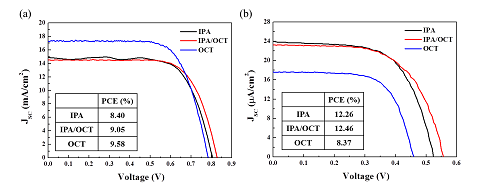
Monalisa Garai
National University of Singapore, Singapore
Title: Single particle spectroscopic studies on two-photon photoluminescence of plasmon coupled gold nanotriangle dimers
Time : 17:15-17:30

Biography:
Monalisa Garai is currently a fourth year PhD student under the supervision of Associate Professor Xu Qing Hua in the Department of Chemistry, NUS. She has done her Master's degree with a specialization in Material Chemistry from the Department of Chemistry, NUS. Before joining NUS, she finished her Bachelor’s degree and Master's degree from the University of Calcutta, India. Her research interests include single particle spectroscopy, plasmonic nanostructures, nonlinear optics and nanophotonics.
Abstract:
Surface plasmon resonance (SPR) coupling between adjacent metal nanoparticles in aggregated nanoclusters results in significant enhancements in many optical responses, such as fluorescence, surface enhanced Raman scattering (SERS) and two-photon photoluminescence (2PPL). Here, 2PPL properties of gold nanotriangle (Au NT) dimers with different spatial arrangements have been investigated on single particle level to understand their different plasmon coupling effects on 2PPL enhancement mechanism and explore the limit of maximum achievable enhancement factor. Compared to NT monomer, scattering spectra of both side-by-side and tip-to-tip coupled NT dimers are red-shifted by 101 nm and 175 nm, respectively with strong polarization dependence along their assembly axis, which can be understood in terms of plasmon hybridization theory. A close resemblance between scattering spectra and 2PPL spectra indicated SPR is the origin of observed 2PPL signal. 2PPL intensities of side-by-side and tip-to-tip dimers are enhanced by 1.0×103 fold and 2.6×104 fold respectively, compared to the NT monomer. Such a huge enhancement in tip-to-tip dimer is a combined effect of plasmon-coupling-induced red-shifted SPR band which has better overlap with the excitation wavelength and giant local electric field amplification due to the presence of sharp tips in inter-particle gap. The influence of sharp tips has been further demonstrated by comparing Au NT monomer and dimers with Au nanosphere (NS) monomer and dimer of similar dimensions. The 2PPL intensity of Au NT monomer is 20 times stronger compared to Au NS monomer, where as that of Au NT tip-to-tip dimer is 93.5 times stronger compared to Au NS dimer. All our experimental results show excellent agreement with numerically calculated integrated |E/E0|4 results. These findings offer a deeper insight in fundamental understanding of plasmon coupling enhanced 2PPL properties and provide a platform for various sensing and imaging applications.

Pietro Cataldi
Italian Institute of Technology, Italy
Title: Fiber networks modified with graphene for durable and versatile flexible electronics
Time : 17:30-17:45

Biography:
Pietro Cataldi is working on the creation of nanocomposites combining plastics and biopolymers with graphene to obtain unconventional multifunctional material. He has completed his Master of Science in Physics in the year 2014. He studied at the University of Genova and at the Berlin Freie University. He has done his Master’s thesis in the Electron Dynamics Group of the Physical Chemistry department at the Fritz Haber Institute of the Max Planck Society. Currently, he is pursuing his PhD in the Smart Materials Group of the Italian Institute of Technology of Genova. He co-authored 5 papers and has participated in four international conferences with an oral contribution.
Abstract:
Flexible and foldable electronic components require materials that can retain their electrical conductivity even after hard mechanical manipulations and multiple folding events. Such a material was realized with two different methods exploiting the combination of all-biodegradable components (substrate and the polymer matrix) and graphene nanoplatelets (GnPs). A fibrous cellulose substrate was sized with a biopolymer-GnPs conductive ink rendering it electrically conductive (sheet resistance ≈10 Ω/sq). The obtained nanocomposite can be used as electrodes for surface electromyography and for terahertz electromagnetic interference shielding. With a similar approach a flexible cotton-GnPs conductive fabric was realized. This material address several drawbacks related to durability and washability of conductive textiles. Micro-cracks formed after repeated folding-unfolding events can be healed through a hot pressing process. Such cotton based conductive composites could find several applications in wearable electronics sector.
Agne KairytÄ—
Vilnius Gediminas Technical University, Lithuania
Title: Mechanical and thermal properties of propylene glycol extended and paper waste sludge modified polyurethane foams
Time : 17:45-18:00

Biography:
AgnÄ— KairytÄ— is a PhD student in Materials Engineering, has participated in national and international conferences as well as projects. Her early researcher career is devoted to the development and research of biopolymers from natural oil-based polyols and ecological as well as energy efficient biopolymer composites from industrial waste. She has knowledge and the problem solving skills essential for performing key areas of technical work as well as quality manager work experience in accredited and notified laboratory of thermal insulating materials.
Abstract:
Polyurethane and polyisocyanurate foams based on vegetable oil polyols are characterised by low thermal stability, high flammability, sensitivity to higher temperatures and lower mechanical performance. The strength may be increased by reducing the cells size, thermal stability and flammability characteristics by using fire retardant materials. There are four species of fire retardants: inorganic fillers, organic phosphorous compounds, nitrogen-based materials, halogenated materials and materials which act as a barrier for flame spread. Organic phosphorous compounds consist of phosphorus and in halogenated materials; carbon forms chains with chlorine and bromine. These fire retardant materials are not biologically degradable and tend to accumulate in the environment. Since halogenated and brominated fire retardant materials are toxic and will not be used in the near future, new ways how to replace such materials with environmentally and to human health friendly materials are of great importance; consequently, in order to improve thermal stability, flammability as well as strength characteristics, organic and inorganic materials or combination thereof are used. Pollution prevention in paper production industry is a worldwide aspiration. One of the main aims of European Commissions and Directives is to transform EU countries into recycling community which is capable of reducing accumulation of waste and using them in different processes. Paper waste sludge is the main and the biggest by-product in paper production process, and its elimination as well as destruction is a primary environmental protection problem. Previous researches have shown that paper waste sludge is porous and its nature – inorganic; however, there is no information on the direct usage in polymeric thermal insulating materials or their composites. The aim of this study is to test paper waste sludge as fire retardant and mechanical properties improving filler in thermally stable polyurethane foam composites from rapeseed oil polyol and water as the sole blowing agent.
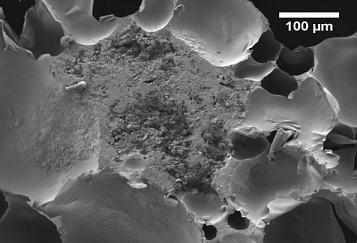
- Session 2: Biomaterials and Medical Devices | Polymer Science and Technology | Ceramics and Composite Materials
Location: Olimpica 3
Chair
Bing Lu
Wanhua Chemical Group Co. Ltd., China
Co-Chair
Loubat Cedric
Specific Polymers, France
Session Introduction
Bing Lu
Wanhua Chemical Group Co. Ltd., China
Title: New development and applications of polyurethane materials
Time : 11:20-11:40

Biography:
Bing Lu is the Director of High Performance Materials Research Center, Wanhua Chemical Group Co. Ltd. He has more than 25 years of research and development experience in the fields of polymer synthesis and products, including olefin polymerization catalysts, olefin polymerization and process, polymer modification and functionalization, polycondensation polymerization, polymer compounding and composites. He is an expert on a variety of plastic materials such as PE, PP, TPO, PBT, PET, PCT, TPEE, POM, CA, LCP, PPS, PEEK, and PU. He has previously worked with Celanese, Formosa Plastics USA, and SINOPEC. He obtained his PhD in Polymer Science from Pennsylvania State University in 1999. He has more than 30 patents and publications.
Abstract:
Polyurethane (PU) materials are versatile with a wide variety of applications. The high demand for lightweight and durable materials from end-use industries such as furniture, construction, electronics and appliances, automotive, footwear and packaging has driven PU growth in recent years. It is projected that the global PU market will reach above USD 105 billion in 2025 from about USD 55 billion in 2016 at a CAGR 7%. The versatility of polyurethanes is highly derived from the wide selection of building blocks available to materials manufacturers. This presentation will review general polyurethane chemistry, polyurethane building blocks and material properties, and further discuss recent development and applications. The growth of polyurethane industries largely depends on the cheap and easily available feedstocks of isocyanates, polyisocyanates, polyols and chain extender co-reactants such as water, alcohols, and amines. The high demand and rapid growth of PU materials in the emerging markets such as China in last two decades has played a significant role in the global PU market, and offered opportunities for petrochemical industry. Wanhua Chemical Group Co. Ltd., in China as one example has emerged and grown as the world top MDI and isocyanates producer. This presentation will also show some of recent development of PU raw materials and products at Wanhua Chemical Group. Some of the new products include PU foams in insulation applications, PU coatings for construction, thermoplastic polyurethane elastomers (TPU), and composites. The future challenges facing polyurethane industry and growth will be also discussed.
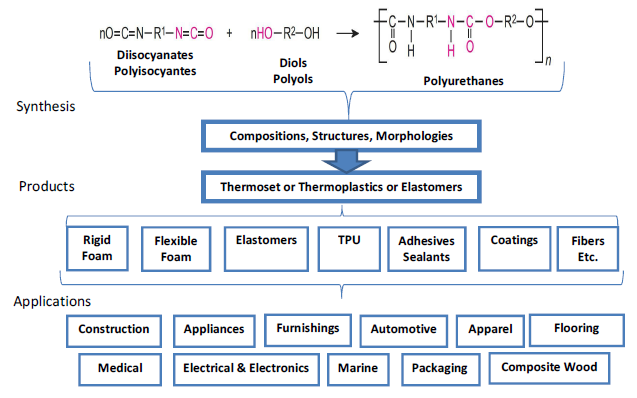
Cedric Loubat
Specific Polymers, France
Title: Specific Polymers – Alkoxysilane and phosphonic acid functional groups to improve compatibility between inorganic surfaces and polymers
Time : 11:40-12:00

Biography:
Loubat Cédric has done his PhD degree in Polymer Chemistry from the University of Montpellier, France in 2000. In 2003, He started Specific Polymers Company with the aim to fill a gap between academic and industrial researches in the field of Polymer Chemistry. Currently, he is the Head of Specific Polymers, and the company has 12 employees
Abstract:
Specific Polymers (2003, Castries, France) is a SME with 12 employees acting as R&D service provider and scale up producer in the field of functional monomers and polymers with high specificity. Through its activities, Specific Polymers is involved in scientific research in various application fields like aeronautic, building industry, biomedical area, automotive, green materials or optoelectronic. Even if the research activity of the company mainly focuses on organic polymers based materials, the problems of interaction between organic and inorganic matters have been the subject of numerous studies. Indeed, in most of the cases, the chemical nature of interaction between the inorganic particles and the polymer drives the performance of the resulting system. In this field, Specific Polymers researches are mainly oriented toward (macro) molecules bearing either alkoxysilanes or phosphonated groups. On one hand, polymers bearing alkoxysilane groups are of a great interest for inorganic material surface modification, preparation of functional nanoparticles, or synthesis of sol-gel based hybrid materials. Indeed, the hydroxyl groups located on the inorganic surfaces can react with the alkoxysilanes moieties of functional polymers conducting to hybrid or composite materials exhibiting outstanding properties. On the other hand, phosphonated groups have the ability to bind metal or metal oxides (iron, aluminium, cerium, titanium, uranium, ITO, gadolinium, nickel, copper, zinc, calcium, quantum dots, nano-metals, etc.) and thus can also be used for functionalization of surfaces or particles. As for example, phosphonic acid functionality was often found to be superior to alkoxysilanes moieties for binding inorganic substrates other than silica, because of the higher robustness and stability of metal-OP over metal-OSi bonds. The interest of both alkoxysilane and phosphonated moieties for surface metal or glass surface modifications,1 functionalization of (nano)particles,2,3 compatibilization of inorganic components into polymeric matrix or functional hybrid sol-gel materials in very versatile applications is highlighted.
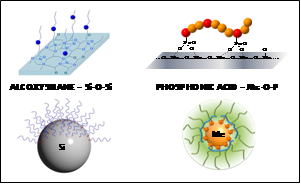
MiloÅ¡ NetopilÃk
Institute of Macromolecular Chemistry, Czech Republic
Title: Improving separation of polymers by size-exclusion and liquid chromatography on the background of the theoretical model
Time : 12:00-12:20

Biography:
Miloš Netopilík has done his Post-graduate studies in Physical Chemistry from Charles University, Prague (1982), PhD (1984) from the Universitas Lucis Spargentis, Wyatt Technology Corporation, Santa Barbara. He was a Research Fellow, Institute of Macromolecular Chemistry, Czechoslovak Academy of Sciences, Prague. In 1998, he was a Senior Research Fellow, Institute of Macromolecular Chemistry, Czechoslovak Academy of Sciences, Czech Republic.
Abstract:
Size exclusion chromatography (SEC) is a widely used method of the separation of polymers according to their size (hydrodynamic radius in the first approximation). The usefulness of the method is increased by benefits of additional detectors (light scattering, viscometer, UV detector) which exploit maximum information about the sample (hyphenated methods). The basic functioning of chromatographic separation can be described by a relatively simple mechanism of establishing equilibrium on each of theoretical plates followed by a shift of the mobile phase by the size of the plate. The model applies for SEC with the separation driven by entropy as well as for liquid chromatography driven by enthalpy. From this observation chromatographic models ensue. The results of the chromatographic models are the band broadening function. The basic mechanism of separation is accompanied by numerous side effects and mechanisms which depend on conditions of analysis, as flow-rate, influencing the equilibrium, the detector-cell volume, etc. The systematic experimental investigation of analysis of polystyrene standards by size exclusion chromatography evaluated on the background of the plate-height model of separation provides the insight into the mechanism and its efficiency, a measure of reaching equilibrium. For polymers of molecular weight about thirty thousand and higher, the separation improved with decreasing flow-rate is in accord with Giddings observation of transversal diffusion as a factor decreasing the broadening of the band broadening function. The variance of the elution curves is larger than it corresponds to dispersity in molecular weight and the shape of the elution curves depends on the experimental conditions which suggest that it reflects properties of the band broadening function. The skew and the excess kurtosis of the elution curves increases near the exclusion limit in accord with theoretical prediction. The excess kurtosis of the elution curves, obtained by SEC of polystyrene standards in tetrahydrofuran using pumps and UV detector DeltaChrome, and one column PL gel MIXED D is depicted in Figure 1. The points for the lowest flow-rate of 0.01 ml/min fit the theoretical line best.
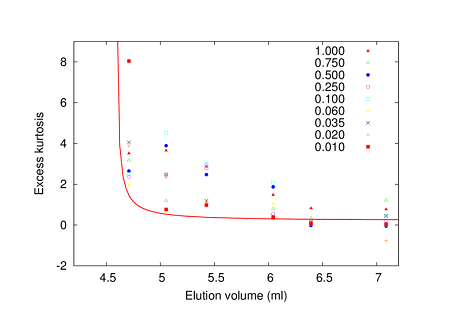
Richard Vendamme
Flemish Institute for Technological Research, Belgium
Title: Sticky degradable bioelastomers
Time : 12:20-12:40

Biography:
Richard Vendamme obtained an engineering degree and a master degree in organic and macromolecular chemistry in Lille (France) in 2001. He subsequently moved to the Max-Planck Institute for Polymer Research (Mainz, Germany) for preparing a Ph.D. dealing with stimuli-responsive liquid crystalline gels. In 2004 he was awarded a JSPS postdoctoral fellowship and started his career at the Institute of Physical and Chemical Research (RIKEN) in Japan, where he notably created a unique class of free-standing nanomembranes. He joined Nitto Denko in late 2007, where his interests extended to various topics such as molecular imprinting, adhesion, green chemistry, sustainability, bio-inspired materials, new business development and the translation of scientific innovations into real-life business cases.
Abstract:
The biological function of natural soft biomaterials is often related to their unique biomechanical properties. For instance, sandcastle worms produce viscous hydrophobic secretions that strongly stick underwater, the adhesiveness of the glue droplets produced by orb-weaving spiders for coating their silk can be explained by the theory of viscoelastic solid, whereas the wing supports of beetles are mechanically very similar to man-made car tires. Synthetic soft biomaterials that mimic some of the elaborated features observed in Nature are attracting the attention of (bio)chemical engineers due to their promising applications in industry, biotechnology and medicine. Among the various classes of materials that have been used to synthesize such substances, polyesters have recently emerged as a versatile and sustainable platform for various reasons (solvent-free synthesis, biodegradability, etc.). In this paper, we investigate the important and often overlooked structure-property relationships underlying the complex viscoelastic and adhesion behaviors of soft polyester elastomers, an emerging class of degradable functional biomaterials and demonstrate that the adhesiveness of these materials can be mainly understood in terms of bulk viscoelastic factors, in contrast to alternative ideas reported in the literature. To that end, we designed a family of poly(isosorbide fatty alkylates) with different molecular architectures and physical aspects (viscous, sticky, rubbery and solid) as model polyester elastomers. Mechanical properties at both small and large strains and adhesion performances have been investigated by various techniques and complemented with theoretical frameworks resulting in the establishment of a new viscoelastic phase diagram depicting generic adhesive archetypes. These results shed some light on the intimate structure of bioelastomers, and notably on the decisive role of a well-adjusted macroscopic cluster of percolated polyester chains for tailoring key biomaterial functions such as elasticity, stickiness, fibrillation and biodegradation. By establishing a bridge between polyester biomaterials and the material science of sticky things, this paper provides robust design principles for diverse functional biomaterials with tailored dissipative characters such as adhesives with tuneable stickiness and degradation profiles, or scaffolds mimicking the non-linear elasticity of soft biological tissues.
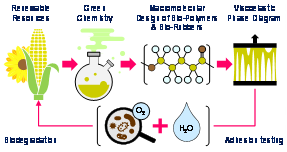
Gerd Kaupp
University of Oldenburg, German
Title: Physics versus non-physical ISO/NIST standards in nano, micro and the numerous macro-techniques are detrimental for daily life: what can be done?
Time : 12:40-13:20

Biography:
Gerd Kaupp has studied Chemistry at the University of Würzburg, Germany and completed Post-doctoral studies at Ames, Iowa, Lausanne, and Freiburg universities, where he became an Associate Professor. He was a Full Professor at the University of Oldenburg in 1982. He served as a Guest Professor for three international universities. He is now a retired member at the University of Oldenburg and pursues his scientific interests also with consulting. His expertise are in chemical kinetics, laser photochemistry, waste-free benign syntheses and productions, solid-state chemistry, reactive milling, atomic force microscopy AFM, scanning near-field optical microscopy SNOM, standardization in nano-mechanics and bionics.
Abstract:
Most mechanical properties of materials are deduced from hardness and elastic modulus. The most used and versatile technique for their detection is indentation mostly with pyramidal/conical diamond tips. ISO-14577 defines and iterates hardness (HISO) and elastic modulus (ErISO) with respect to projected contact area (Ahc=const∙hc2) with (nearly) legal character, but without consideration of the energetics involved (Figure 1), which therefore triply violates basic physics. Still applied older indentation techniques such as Vickers, Knoop, Brinell, Rockwell, and Shore hardness are even more empiric and they include at least the same violations. Nevertheless, they are still widely accepted without trying to develop a sound physical foundation. Thus, the normal force (FN) is not proportional with h2, but with h3/2 as physically founded and experimentally confirmed. The dimensional error for hardness and elastic modulus are clearly violating the first energy law, and the wrong exponent also prevents the detection of phase transitions under load, which requires that only loads below the phase transition onset should be used for material’s characterization. While such onsets mostly occur within the 100 µN range, some require the mN and up to >10 N range, where multiple phase transitions generally occur with the additionally risk of macroscopic cracking (for example NaCl to CsCl-type at 4.233 mN followed by CsCl to CrB-type at 2.49 N without cracking). The way for a physical treatment of indentations has been paved with FN=kh3/2 plots since 1990 (k after energy correction factor 0.8 is the material's penetration resistance), but without appreciation from the establishment despite the most serious flaws including the violation of the energy law: The concomitant shear-force work for building up pressure and plasticizing cannot be assumed to be workless created. The pressure has even been used for the elastic modulus determinations. It does not help that the older very high-force techniques rely on the diameters of the impression surface such as Vickers, Knoop, Brinell (they are convertible into the depths), or that Rockwell and Shore measure depths. Problems with cracks (this does not mean cracks upon reloading for fracture toughness) are not reported but different load ranges distinguished and empirical inter-conversion formulas used. The physically valid HPHYS can now be obtained by linear regression of the loading curve's FN=k h3/2 plots (ErPHYS requires additionally stiffness) without the three flaws (Ref. 11), omitting iterations with simplest arithmetic. It is now valid for all types of materials and all instrumental depth sensing techniques. The dilemma of the ISO standards against physics and thus the “legally enforced” calculation of wrong mechanical properties are detrimental, producing very large errors. Liability problems in case of materials failure ensue. Textbooks and instrument software must be rewritten, the ISO-14577, a NIST tutorial, and numerous publications retracted. Instead, the physical correctness must be installed for the sake of daily life security. Examples will be discussed. ISO appears slow in changing its standards for complying with physics. They are asked to release an urgent caveat, telling that ISO-14577 will be subject to redefinitions for physical reasons.

Ana RamÃrez Ledesma
Instituto de Investigaciones en Materiales, Mexico
Title: Fabrication of Co-Cr alloys for biomedical applications by implementing rapid solidification
Time : 14:00-14:20

Biography:
Ana Ramírez – Ledesma has her expertise in rapid solidification techniques for Co-Cr alloys and Zn based alloys. Her innovative and non – conventional solidification techniques creates a new line of investigation for improving their performance in the biomedical field. Moreover, her collaboration with medical institutions (e. g. National Institute of Cardiology (INC, México, Ciudad de México) will allow the technological development of cardiovascular prosthesis which will be easily accessible for Mexican population. She was awarded with the CONACYT scholarship for doctoral studies and conclude her Ph. D. in the Materials Science and Engineering Program (UNAM) at Materials Research Institute (UNAM). Actually, she has a close collaboration with Dr. Hugo Lopez which is an expert with over 20 years of experience in the field of biomedical grade cobalt based alloys.
Abstract:
Statement of the Problem: It is well known that actually there is a lack of innovation with respect solidification processes on Co-Cr based alloys for biomedical applications (e. g. dental implants and permanent stents). Moreover, the most conventional technique to obtain Co-Cr biomedical devices is the investment casting process. Which involves inherent microstructural defects as a high percentage of interdendritic segregation and several precipitates distributed along the microstructure. All these features results in a decrement of the mechanical properties in Co-Cr alloys used in the biomedical field. Methodology & Theoretical Orientation: High purity cobalt (99.99 %) and chromium (99.99 %) were used as starting metals for processing the experimental Co-Cr alloy. Rapid solidification regime was confirm trough the temperature profile recorded using an Amprobe TMD90A Digital Thermometer with R type thermocouples inserted into a ceramic sheath, embedded in the cooling metal. Findings: Rapid solidification promotes the elimination of interdendritic segregation and, in consequence, a diminution of precipitates can be achieved. On the other hand, a control in the γ-Co, FCC ↔ ε-Co, HCP transformation were reached. The above microstructural and crystallographic features are related with the improvement on the mechanical properties and corrosion resistance on Co-Cr alloys. Theoretical solidification models were used to understand several features of rapid solidification regime imposed on Co-Cr alloys. These consist in a competitive growth analysis to predict the growth temperature limits of the eutectic constituent and the solid solution for the alloy system. Conclusion & Significance: Nowadays, Co-Cr alloys still are very important in the biomedical field. For this reason, it is important and necessary to propose alternative and innovative solidification procedures to fabricate Co-Cr biomedical devices. Consequently, we can improve their mechanical and corrosion properties significantly through a microstructural control.
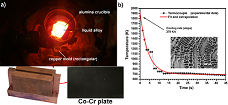
Antonio Zuorro
Sapienza University of Rome, Italy
Title: An enzymatic-based process for the extraction of fibers from diss stems with for composites reinforcement
Time : 14:20-14:40

Biography:
Antonio Zuorro is a Professor of Biochemical Engineering Fundamentals and Chemical Engineering for BioMedical Systems in the Department of Chemical Engineering Materials and Environment of Sapienza University of Rome. He received his MS and PhD degrees in Chemical Engineering from Sapienza University of Rome. His research activity has been mainly focused on the development of innovative chemical and biotechnological processes for the recovery of high value-added compounds from by-products and agro-industrial residues, such as lycopene from tomato waste and phenolic antioxidants from artichoke and bilberries waste, olive pomace and coffee grounds. He also examined the possibility of including the extracts obtained in consumer food products to get new functional foods with high antioxidant activity. In the field of enzyme technology, he studied the use of multi-enzyme systems with enhanced activity for the recovery of lipids and bioactive compounds with high added value from microalgae. He is the author of over 60 scientific publications and several industrial patents, ranging from the biochemical extraction of valuable compounds to the fibers recovery for material applications.
Abstract:
The diss plant (Ampelodesmos mauritanicus) is an herbaceous perennial plant of the family Gramineae that lives on arid and sandy soils, typical of Mediterranean grassland. The species is widespread in North Africa, in coastal areas of Spain, France, Balkan, Turkey and Italy (in particular, on the arid coastal slopes of the Center-South, in Sicily and in the coastal region of Liguria). Its stems are composed of cellulosic filaments linked by lignin, pectins and hemicellulose. Short fibers can be obtained from the stems by aggressive extraction methods which eliminates the binders. They can be used for paper production. On the other hand, the extraction of long and flexible fibers, useful for the production of reinforcement of composites, is not yet developed and is therefore the subject of this work. Stems were treated with 0.25 M KOH in autoclave at 140ºC for 1 h in order to remove lignin, in the presence of 1.5% of sodium hydrosulfite used as reducer agent. Delignified stems were then treated with different enzymes (pectinases, xylanases and a mixture of them) for pectin and hemicelluloses removal. This treatment was performed at 50ºC, pH 4.5 for 1 h. The effect of enzymatic treatments on the morphological, chemical composition and mechanical properties of diss fibers was investigated and the effectiveness of enzymatic treatments has been evaluated. The results indicate that the tensile properties of fibers were greatly improved when an optimized enzymatic-based process was used to separate the fibers from the stems. This work also showed that enzymes offer an attractive and eco-friendly approach to extract plant fibers.
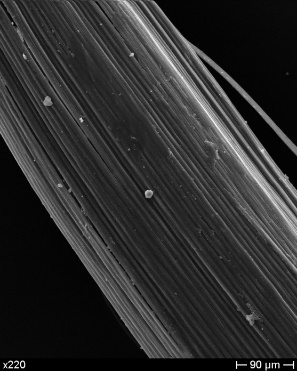
Damia Mawad
University of New South Wales, Australia
Title: Flexible and soft bioelectronics for the biotic/abiotic interface
Time : 14:40-15:00

Biography:
Damia Mawad has been appointed a lecturer at the School of Materials Science and Engineering, UNSW Australia in August 2015 after completing her Marie Curie International Incoming Fellowship in Imperial College London, UK. From 2008 to 2012, she was a Research Fellow at the Intelligent Polymer Research Institute, University of Wollongong. Her research interests are in polymeric biomaterials applied in tissue engineering. One of her main investigations is development of electroactive and conductive scaffolds for biomedical applications with emphasis on material chemistry and design strategies that transition from a monomer to a polymer to 3D construct. Examples include conductive porous hydrogels that induce cell attachment, proliferation and differentiation and conductive bioadhesives for cell alignment and photoadhesion to tissue. Recent research output in Science Advances on how to manipulate the cardiac conduction velocity after a heart attack was featured in international news outlets attesting to the novelty of the investigations.
Abstract:
Statement of the Problem: Damaged electroresponsive tissues such as spinal cord injuries and myocardium infarctions malfunction due to disruption in the bioelectric signal propagating along the tissue. Flexible and soft organic bioelectronics are being explored as biomaterial-based approaches applied on the biotic/abiotic interface to electro-couple with the tissue and restore the electric signal. However, the clinical application of organic conducting polymers (CPs) has been mainly hindered by their short term operational lifetime in physiological conditions and their hydrophobicity that impedes nutrients transfer needed for cell survival. Furthermore, fixing these flexible bioelectronics on soft tissue can be challenging and requires invasive suturing techniques. The purpose of this research is to develop novel bioelectronics with tailored chemistries that address the aforementioned limitations with proven electrophysiological effect on electroresponsive tissues such as the heart. Methodology: By manipulating the chemistry of conjugated backbones, conductive constructs such as a hydrogel doped with large polyelectrolyte or free standing patch doped with small anion were fabricated. The chemical components of the patch permitted adhesion to tissue by light activation. In vitro and in vivo experiments were conducted to investigate how these conductive scaffolds interact with tissues. Findings: New generation CPs were synthesized with demonstrated biocompatibility and ease of processability. The conductive hydrogel is demonstrated to be a suitable 3D hydrated network that promotes the proliferation of C2C12 muscle cells and exhibits electroactivity in physiological media (Fig. 1A). The patch is shown to have an extended electronic biostability, adheres to tissue without the need of sutures and electro-couple with infarcted cardiac tissue enhancing the conduction velocity of the electric signal across scar tissue (Fig. 1B). Conclusion & Significance: By modifying the chemistry of CPs, these macromolecules could be fine-tuned into functional materials opening the way for the development of novel multifunctional bioelectronics capable of electro- coupling with biological tissues.
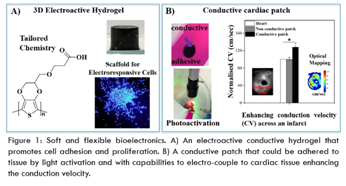
Jorge Macanás de Benito
Polytechnic University of Catalonia, Spain
Title: Strategies for enhancing interfacial adhesion between chicken feather filler and thermoplastic matrices in biocomposites
Time : 15:00-15:20

Biography:
Macanás J is an Associate Professor in the Department of Chemical Engineering at Universitat Politècnica de Catalunya. His present research is mainly focused on Materials Science and Nanotechnology. He has developed some metal-polymer nanocomposites with different configurations for environmental and catalytic applications. He is currently working on the valorization of several industrial residues as materials with approaches such as the reported here.
Abstract:
Statement of the Problem: Millions of tons of chickens are sacrificed every year for meat production generating at the same time a proportional amount of animal byproducts (ABPs) not intended for human consumption. Among these ABPs, chicken feathers (CFs) represent around 5-7% of the total chicken weight and currently are mainly treated as a waste by landfilling and/or incineration. During last year’s there has been an interest to valorize CFs to obtain value-added products such as biocomposites, biosorbents, filter media, insulation materials and tissue engineering scaffolds. However, in the case of biocomposites, it was demonstrated that mixing CFs with thermoplastic matrices was not effective in terms of mechanical properties due to the lack of compatibility between the components. So, the purpose of this study was to apply methods for improving mechanical properties of CFs based biocomposites by promoting interfacial adhesion between CFs and polyolefinic matrices. On one hand, some functionalizing treatments such as silanization and acetylation were performed to CFs and, on the other hand, a partial substitution of the matrix by adhesion promoters, such as maleic anhydride modified polymers (MAPs) was proposed. The effect of such modifying strategies on the mechanical properties was studied.
Methodology & Theoretical Orientation: CFs were stabilized by an oxidative treatment. After that, fractions of the CFs were treated with methacryloxypropyltrimethoxysilane and with acetic anhydride for their silanization and acetylation, respectively. Treated CFs were used to prepare biocomposites by mixing 20% v/v of CFs with either PP or LDPE in a Brabender mixer. Alternatively, biocomposites were prepared by substitution of polymer matrices with MAP adhesion promoter (Fusabond® P613 or M603, DuPont, USA). Tensile tests were carried out to determine mechanical properties.
Findings: Silanization and acetylation did not improve the mechanical properties of biocomposites. However, the incorporation of MAPs additive causes an improvement of tensile strength of the biocomposite (see image for PP).
Conclusion & Significance: Mechanical properties of CFs thermoplastic biocomposites were improved using MAPs which enhance the interfacial adhesion between CFs and polyolefinic matrices.
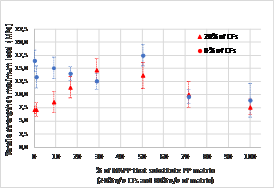
Hong Yee Low
Singapore University of Technology and Design, Singapore
Title: Geometry and size dependent structural reversibility of sub-micrometer polymer structures
Time : 15:20-15:40

Biography:
Hong Yee Low received her education in the field of Polymer Science and Engineering from Case Western Reserve University, Cleveland, USA. In the past 15 years, her research interests and activities have been in nanofabrication of polymeric structures and in the studying the surface properties of micro- and nanoscale surface patterns. In her research, nano-imprint process has been the primary fabrication technique used for creating a variety of complex, quasi 3-dimensional micro- and nanoscale surface patterns. Biomimicry is also an approach she has adopted in developing novel surface structures and functionalities. The surfaces developed by her research group have been applied in applications ranging from electronics, biomedical and optical devices.
Abstract:
Highly uniform, sub-micrometer surface patterns have been actively investigated as non-chemical means of surface engineering. Surface functionalities such as wetting, friction and optical effects can be engineered through a variety of micrometer and nanometer surface patterns; such functionalities are greatly influenced by geometries and length scales of the surface patterns. Changes to the geometry and the sizes of the surface pattern can result in changes in the associated surface functionalities or have implications on the durability of the surface functions. In this study, a systematic quantification of the mechanical deformation and the recovery of nanoimprinted sub-micrometer polymers have been conducted. Shape memory polymers Nafion and polyurethane acrylate (PUA) were programmed with permanent shape memories of the surface patterns via high temperature nano-imprinting. Surface patterns ranging from 2 micrometer to 200 nm were investigated under uniaxial tension and compression. The geometrical deformation and recovery of the surface patterns were quantified using atomic force microscopy (AFM). A schematic methodology employed in this study is shown in figure-1. Geometrical deformation and recovery were found to be dependent on the pattern size, aspect ratio and geometries (isotropic versus anisotropic, protrusion versus recess structures). A transition in deformation mechanism was also found to be dependent on the size and aspect ratio of the structures (figure 2). Understanding the mechanical deformations of these surface patterns is important towards achieving durable surface patterns, their functions and opens new opportunity for engineering active surface patterns.
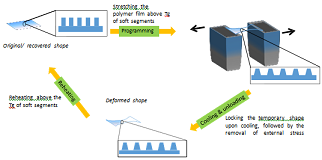
Thomas Fiedler
University of Newcastle, Australia
Title: Perlite metal syntactic foam (PMSF) in impact engineering
Time : 15:40-16:00

Biography:
Thomas Fiedler has completed his Master’s degree in Mechanical Engineering from the University of Erlangen-Nuremberg (Germany) in 2004. He continued his academic career at the University of Aveiro (Portugal). After completing his PhD in 2007, he started working as a Post-doctorate at the University of Newcastle, where he is currently working as an Associate Professor. He has research expertise in cellular materials (metals and ceramics) and composite materials, experimental and computational mechanics, finite element methods, Monte Carlo methods, and mechanical and thermal material testing.
Abstract:
Metallic foams exhibit a relatively constant deformation resistance during compression. As a result, they are highly attractive for impact engineering where controlled energy absorption and deceleration is required. Over the past decades, metallic foams have attracted growing interest due to their unique and multi-functional properties. However, to this date they have often failed to become a viable commercial solution. The key inhibitors are their high cost and the variability of mechanical properties. Perlite metal syntactic foam (PMSF, see Fig. 1) is a novel material that has the potential to overcome both limitations. It combines inexpensive raw materials (i.e., expanded perlite particles and standard casting alloys) with a close control of geometry and hence mechanical properties. In the presented study, PMSF is probed for its suitability as the energy absorbing element of an automotive crash cushion. In the first step, the desired material properties are derived from the permissible forces during the impact. In the following, the mechanical properties of PMSF are tailored to meet these requirements. This is achieved by increasing the perlite volume fraction and selecting pure aluminum as the metallic phase. To prevent the likelihood of global buckling a PMSF cylinder is selected as the energy-absorbing element. The component is tested both numerically and in a 2.5 tons drop test that replicates the forces occurring during an automotive impact.
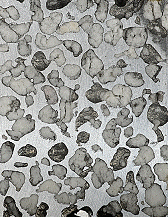
Kanchan Mondal
Southern Illinois University, USA
Title: Synthesis and characterization of titanium carbide nanofibers using a modified carbothermal reduction process
Time : 16:25-16:45

Biography:
Kanchan Mondal has her expertise in process and materials development and conducts research to find holistic solutions for a sustainable energy future.
Abstract:
Statement of the Problem: Single phase titanium nanofiber synthesis is a challenge. In this paper, the synthesis of titanium carbide nanofibers using a carbothermal process will be presented along with the thermal, mechanical and electrical properties.
Methodology & Theoretical Orientation: Titanium oxide nanofibers were fabricated by electrospinning method from a sol containing a mineral acid for peptizing, followed by calcination at temperatures ranging from 250-800ºC. Various carbothermal routes of production of these high L/D structures will be shown and the impact of processing routes on the morphology will be discussed. One route involved the coating of carbon on the oxide nanofibers by cracking of propylene (C3H6). Carbon coated titania fibers were reacted at 1400ºC and 1500ºC for 1 or 2 hours under argon atmosphere to form titanium carbide nanofibers. The titanium carbide nanofibers were characterized using scanning electron microscope (SEM), transmission electron microscope (TEM and HRTEM), and X-ray diffraction (XRD).
Findings: The average diameter of the TiO2 fibers and TiC fibers averaged at 150 nm and 350 nm, respectively. Due to the high conductivity, chemically and electrochemical stability in strong acid and high potential environment, the synthesized TiC fibers show great potential for fuel cell applications such as support of bipolar plates and catalyst support. The data also show the potential EDLC applications of these fibers. The electrical, mechanical and thermal properties of the synthesized TiC will be reported and compared with the theoretical values.

David Lokhat
University of KwaZulu-Natal, South Africa
Title: Highly dispersed zinc based sorbents for hot gas desulphurization: Synthesis and application
Time : 16:45-17:05

Biography:
David Lokhat is the Head of the Reactor Technology Research Group of the School of Engineering at the University of KwaZulu-Natal in Durban, South Africa. His research interests are in catalysis and reactor engineering, specifically process intensification, high temperature processes and applications in fluorochemistry. In 2013, he received the South African Institute of Chemical Engineers Innovation Award for the development of a novel continuous process to produce a fluorochemical intermediate.
Abstract:
Most hydrocarbon fuels like petroleum, natural gas and coal contain other elements in small quantities which, after high-temperature processing, are transformed into various impurities. These impurities include compounds of sulphur. Conventional methods of desulphurization involve absorption of the acid component using regenerative solvents moving counter currently with the fuel derived gas in an absorption column. Desulphurization may also be accomplished using solid sorbents such as metal oxides. This study focused on the enhancement of sulphur removal capacity and regeneration characteristics of solid mesoporous zinc-based sorbents through ultrasound assisted dispersion of active components. The investigation attempted to determine if sonication during wet impregnation of the prepared precursor materials would yield a sorbent with highly dispersed metal oxide content and if the improved dispersion would result in enhanced sorbent capabilities. ZnO/SiO2 sorbents using the wet impregnation technique were prepared using a ZnCl2 precursor solution. The efficacy of the prepared sorbents was tested for hot gas desulphurization using a high temperature flow-through apparatus. A synthetic coal gas was used. Experiments were conducted at temperatures of 350-500ºC and space time of 67500 h-1. Breakthrough curves for H2S absorption were constructed from temporal measurements of the H2S concentration in the exit gas stream, using a gas chromatograph equipped with a flame photometric detector. Sonicated sorbents had comparably better desulphurization breakthrough times (on average a 50% increase) than non-sonicated sorbents. It was confirmed that the sorbents prepared via the ultrasonic-assisted impregnation technique had enhanced breakthrough times and saturation capacities.

Ali Kalkanli
Middle East Technical University, Turkey
Title: Melt infiltration casting of alumina, silicon carbide and boron carbide reinforced aluminium matrix composites
Time : 17:05-17:25

Biography:
Ali Kalkanlihas has his expertise in processing of aluminum, magnesium alloys and metal matrix composites. He completed his MS thesis on metal powder atomization at METU Turkey and PhD thesis on melt overflow stainless steel strip casting processing in Milton Keynes at Open University, England. Alloy development and various casting and metal processes are his main interest areas.
Abstract:
A series of metal matrix composites were produced using 7075 and 7085 aluminum alloys as matrix alloys and Al2O3, SiC and B3C4 seramic preforms. Melt infiltration casting was performed with a vertical squeeze caster applying 70 ton pressure during processing. Sintering of ceramic preforms were carried out at 1000, 1100 and 1300ºC for one hour then preheated hot sintered preforms at 1000ºC were placed into a die cavity before aluminum infiltration casting. During processing vertical 70 ton and upward 40 ton hold down pressure was applied for three minutes for melt infiltration. Mechanical characterizations were done by three point bending tests and flexure strength values obtains for 7075 alloy infiltrated Al2O3 preforms as 520-600 MPa.
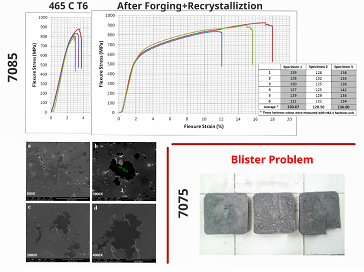
Rahul Madathiparambil Visalakshan
University of South Australia, Australia
Title: Biomaterial surface modification to control inflammation: Effect of nanotopography and surface chemistry on protein adsorption and cell response
Time : 17:25-17:40

Biography:
Rahul M Visalakshan is pursuing his PhD in Biomaterial Engineering and Nanomedicine from School of Engineering University of South Australia. He is working on his thesis titled “Surface Engineered Biomaterials to Control Inflammation”. He has won Australian Post-graduate Award Scholarship to pursue his PhD. He is a graduate from University of East London, UK where he received his Master’s in Biotechnology and Management. He completed his Bachelor’s in Biotechnology from Mahatma Gandhi University, India.
Abstract:
Biomaterial surface nanotopography and chemical functionalities have been shown to play a critical role in modulating the host immune response. Studies have demonstrated that the effect of surface characteristics are translated through the surface adsorbed protein layer to the immune cells. Recently, various techniques have been developed to create surfaces with nanotopography to control protein and cell responses. Most of these studies attempted to produce nanotopography by etching the surface to incorporate pores, grooves, and pillar structures. However, inconsistent topography, chemical functionalities and lack of reproducibility resulted in conflicting reports. Therefore, we developed a technique that can produce well-defined and reproducible topography to identify the role of specific roughness size, height, density and presence of homogeneous chemical functionality. Using plasma polymerization of oxazoline monomers and immobilized gold nanoparticles, we created surfaces with an equal number density of nanoparticles of different sizes. This surface was used to study the role of surface nanotopography and the interplay of surface chemistry on proteins and cells. Effect of nanotopography on fibrinogen adsorption was investigated using quartz crystal microbalance with dissipation and the mass of fibrinogen adsorbed were decreased on surfaces with increasing nano-topography. Cell responses such as adsorption and proliferation were studied using human dermal fibroblasts.
Samaneh Pourmohammadimojaveri
Western Sydney University, Australia
Title: High performance rubber concrete
Time : 17:40-17:55

Biography:
Samaneh Pourmohammadimojaveri joined the Western Sydney University in 2014, as a PhD research student. She Her PhD research has been focused on developing a framework for optimum use of recycled materials such as waste tyre rubber in concrete construction
Abstract:
For centuries, the researchers have been trying to make life easier for everyone, all the achieved technologies in material, civil, mechanical, chemical, electrical and other fields of engineering are appreciated and valued. Many scientists worked on how to get to the next level of development in all areas during the last decades, and as a result of that mankind enjoys a better life these days. But achieving all these developments without concern for the environment has resulted in some serious environmental damages such as global warming, stockpiling solid wastes in outdoor areas, fire, disease and poisoning.
Nowadays, to resolve the said problems all over the world, there are several organizations focused on manufacturing and distributing sustainable and recycled products such as recycled tyre rubber, and etc. Also there are some market leaders in delivering sustainable products to customers in Civil Infrastructure, Building and Construction, Transport and other industries. But still the problem is standing and it seems the progress is rather slow. To reduce the resulting environmental impacts is for researchers to propose new products considering not just the scientific benefits, but also addressing sustainable development as a major concern more than ever in their projects.
The current research is based on using recycled wastes such as vulcanized rubber of used- tyres and trying to turn them into value added materials to achieve better quality. These recycled materials in some concrete applications after being modified chemically in order to obtain a product with enhanced physical, mechanical, thermal and structural properties, will decrease the impact of these waste materials on the environment. Due to high demand for concrete and its applications in all countries, the outcome of this research could make a big change in construction materials and technology for the future.
Burak Cagri Ocak
Istanbul Technical University, Turkey
Title: Investigation of the microstructure and oxidation properties of NbB2-SiC-GNP composites
Time : 17:55-18:10
Biography:
Burak Cagri Ocak has a Bachelor’s degree in Metallurgy and Materials Engineering from Istanbul Technical University. He also received his Master’s degree in Materials Engineering and did his thesis work on ultra-high temperature ceramics. Currently, he is pursuing his Doctoral education from the Istanbul Technical University.
Abstract:
Niobium diboride (NbB2), ceramic is characterized by an excellent combination of properties comprising high melting point, hardness, wear resistance, thermal conductivity, good creep resistance, and excellent chemical stability. However, difficulties in densification, low fracture toughness and poor oxidation resistance of NbB2 limit the use of these materials. A number of studies have shown that addition of SiC improves the oxidation resistance by forming a protective SiO2-rich layer and improve fracture toughness of transition borides. Moreover, recent studies have demonstrated that graphene nano-platelets (GNP) addition can significantly enhance the mechanical properties of ceramic matrices. In this study, GNPs were incorporated into (20-x)SiC-80NbB2 (vol.%) composite powder with x=0, 0.5, 3, 5, 7 and 10 vol.% contents. The resulting powder mixtures were sintered by spark plasma sintering (SPS) at 1750ºC under 50 MPa with a 5 min holding time. The sintered composites were then characterized with respect to their densification, microstructure, oxidation behavior and mechanical properties change with the combination of SiC and graphene nano platelets. Improvement in oxidation resistance as a result of formation of protective layers and fracture mode change with the incorporation of SiC and GNPs will be discussed in this presentation.

